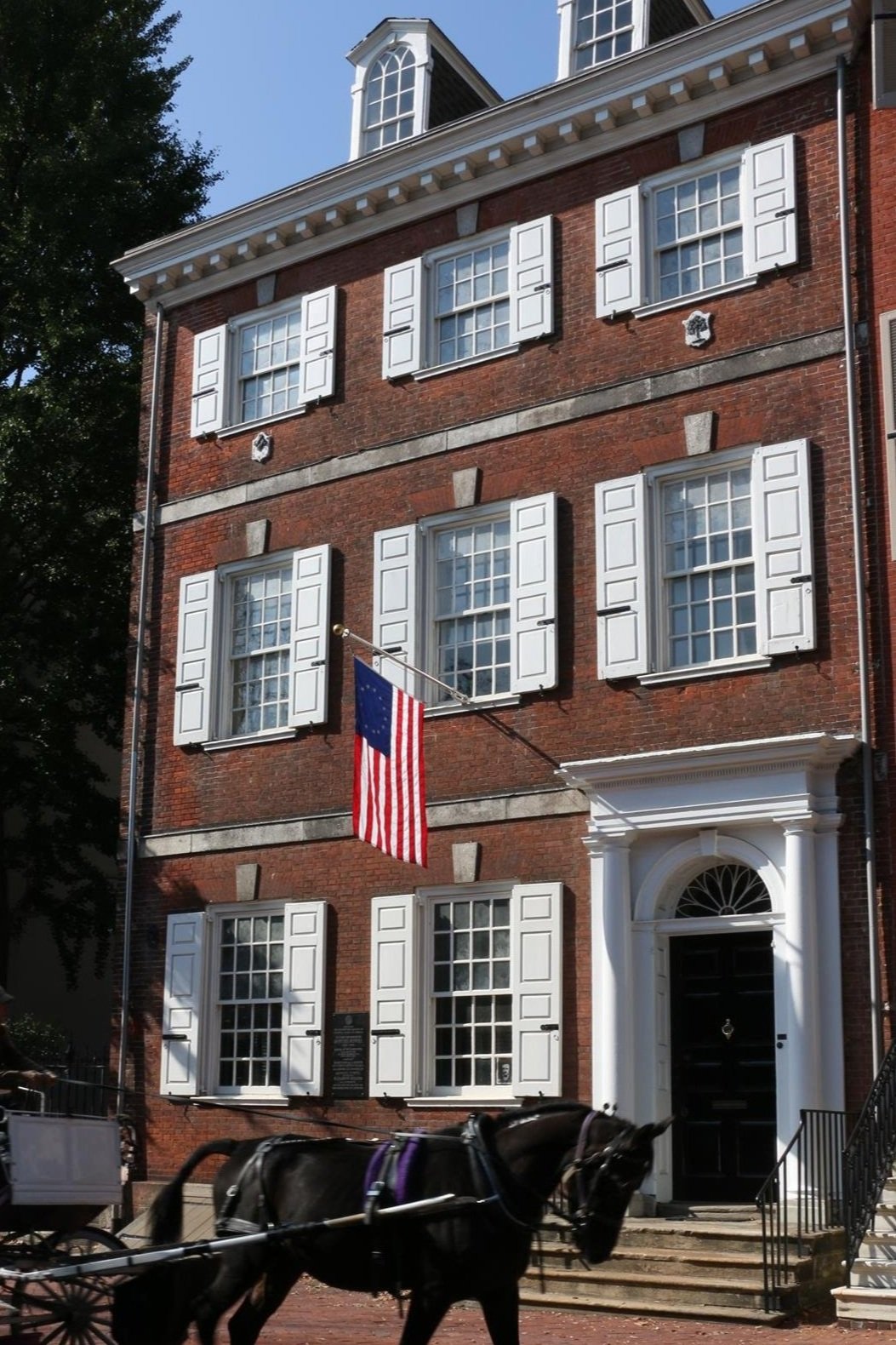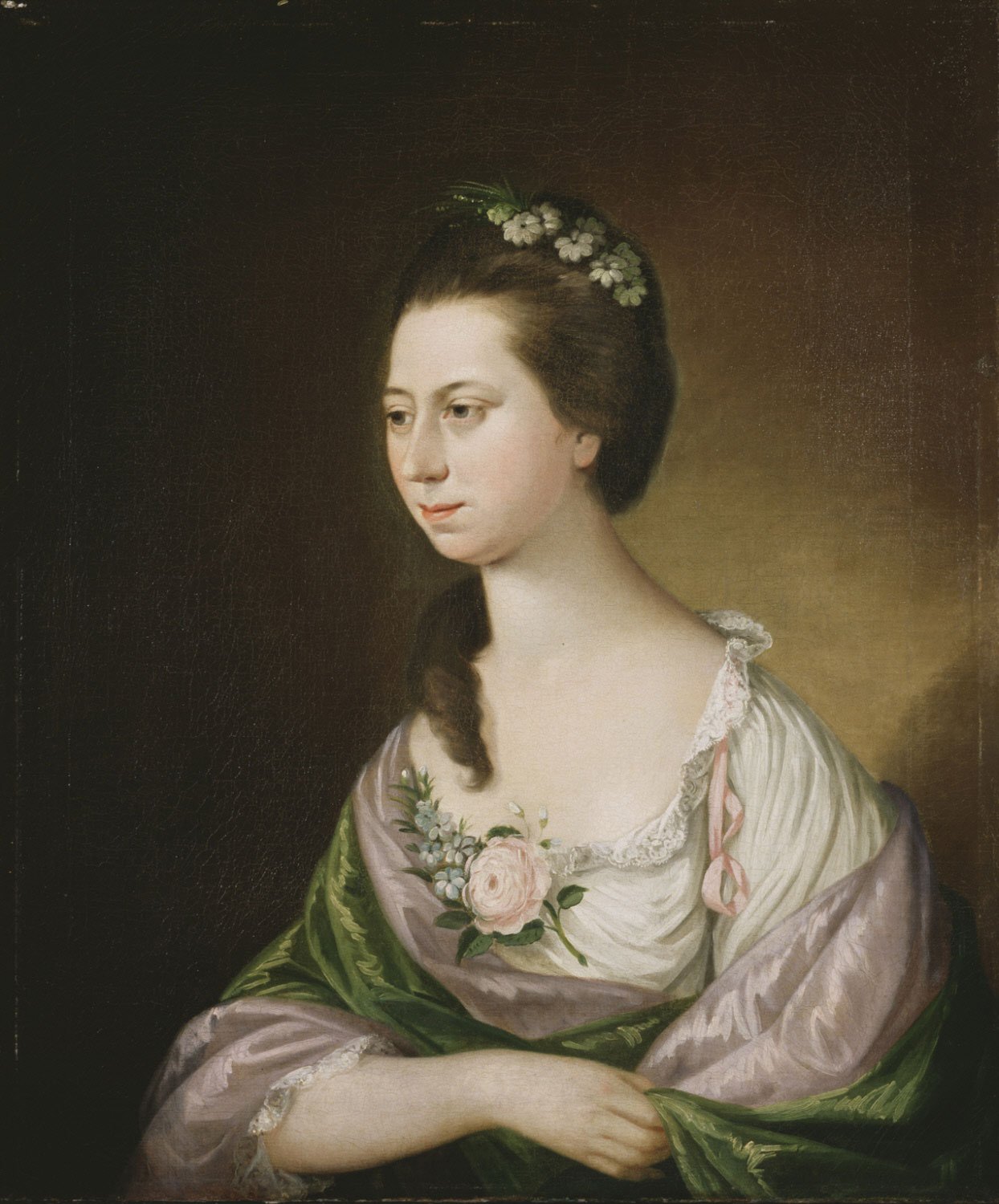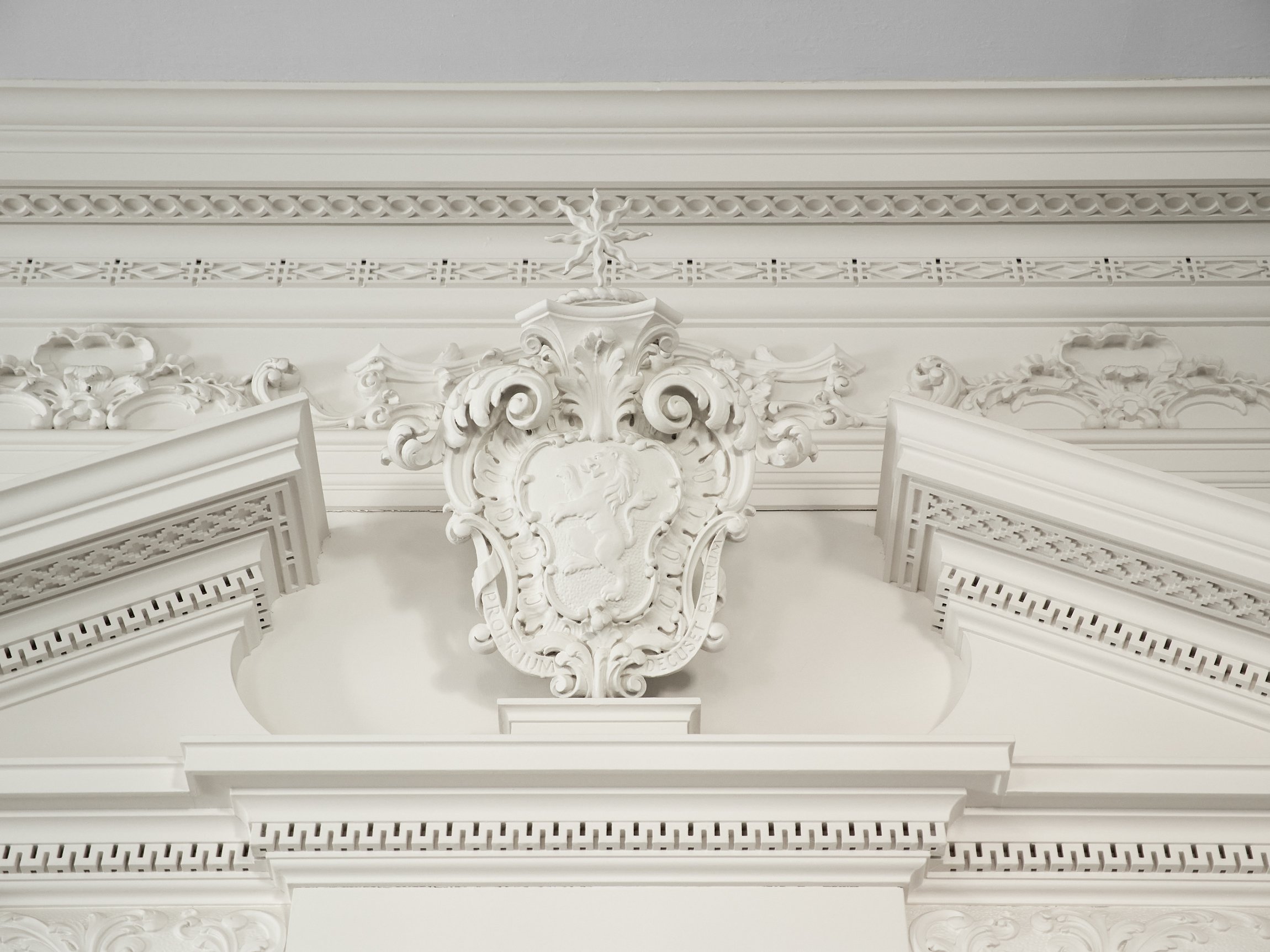
POWEL HOUSE
Powel House
Philadelphia 1765
Built in 1765, the three-bay, red-brick Powel House is considered one of the finest examples of Georgian architecture in the United States.
In 1769, Samuel Powel purchased this newly built house from the merchant and land speculator Charles Stedman. As newlyweds, he and his new bride, Elizabeth Willing Powel, immediately began redesigning the house’s interior. The Powels hired Philadelphia’s leading carvers and craftsmen to decorate the house’s principal rooms. James Claw created the elaborate Rococo design of the carved ceilings in the ballroom. Hercules Courtenay carved the exquisite ornamental mantel, along with the cornices, paneling and baseboards. Nicholas Bernard and Martin Jugiez carved the stunning mahogany staircase.
Samuel Powel is often called the “Patriot Mayor,” serving as the last mayor under the British Crown and the first mayor in our new American republic. Powel was not only a real estate mogul, land investor, merchant, politician, and trustee, but he was among the richest men in Philadelphia.
His wife Elizabeth Willing Powel was an equally seminal figure in our country’s founding. She not only lavishly entertained the political elite during the drafting of the Declaration of Independence and the Constitution, but she was also educated, smart, and had a powerful, opinionated voice. Elizabeth Powel became one of George Washington’s closest confidants, before, during and after his Presidency.
In the late 19th century, the Powel House stood witness as the “Old City” neighborhood was industrialized. The property’s newest owner (1904) Wolf Klebanksy was using the house for warehousing his horsehair and bristle business. By 1931, the Powel House had deteriorated significantly and faced its greatest risk — demolition to make way for a parking lot.
The fact that “this was the house where George Washington danced” became the rallying cry, inspiring PhilaLandmarks’ Founder Frances Anne Wister to corral her wealthy friends to purchase this historic house and save it from destruction.
Powel House Interior Rooms

Photo by Joe Pulcinella

Photo by Joe Pulcinella
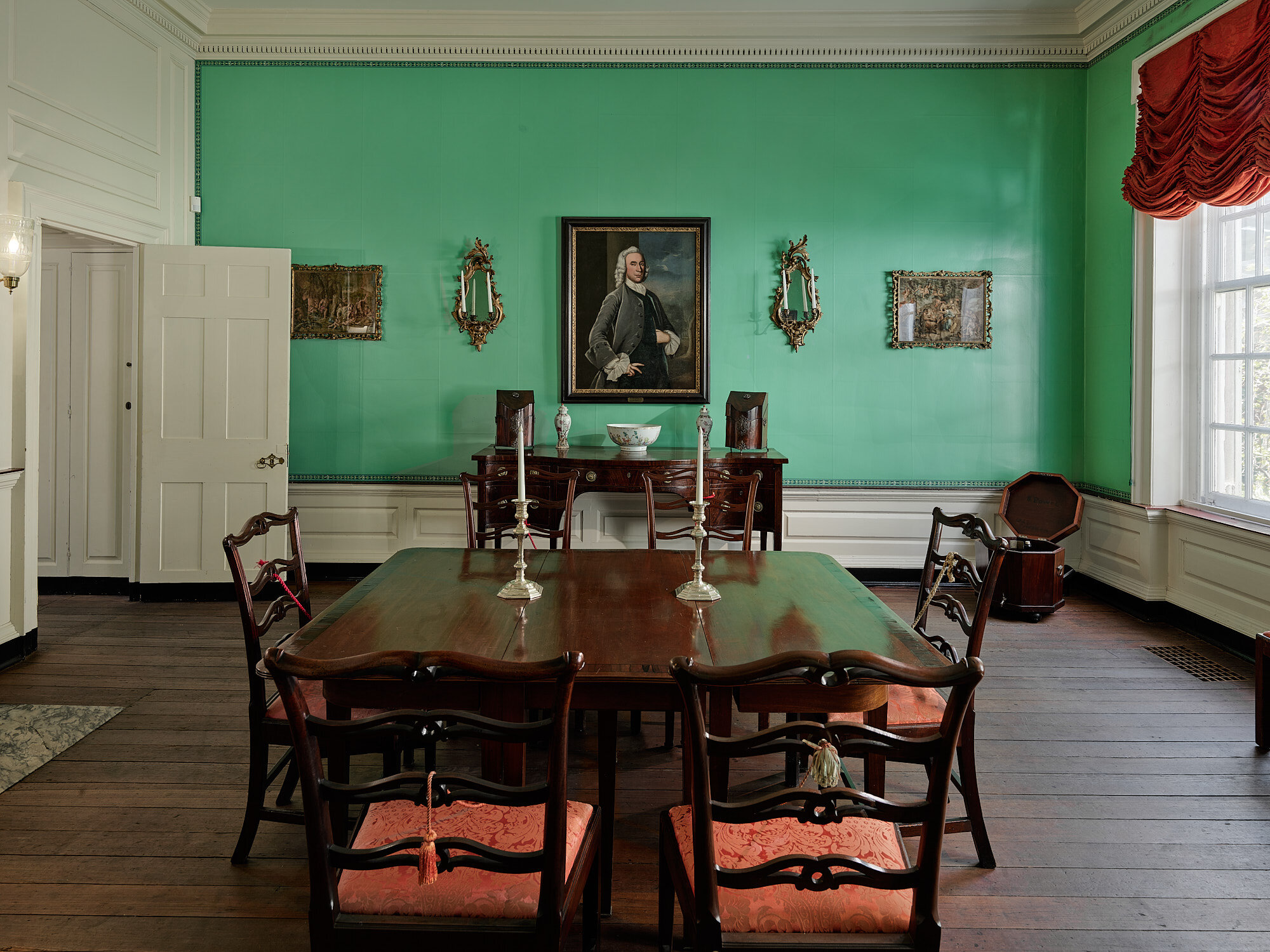
Photo by Joe Pulcinella
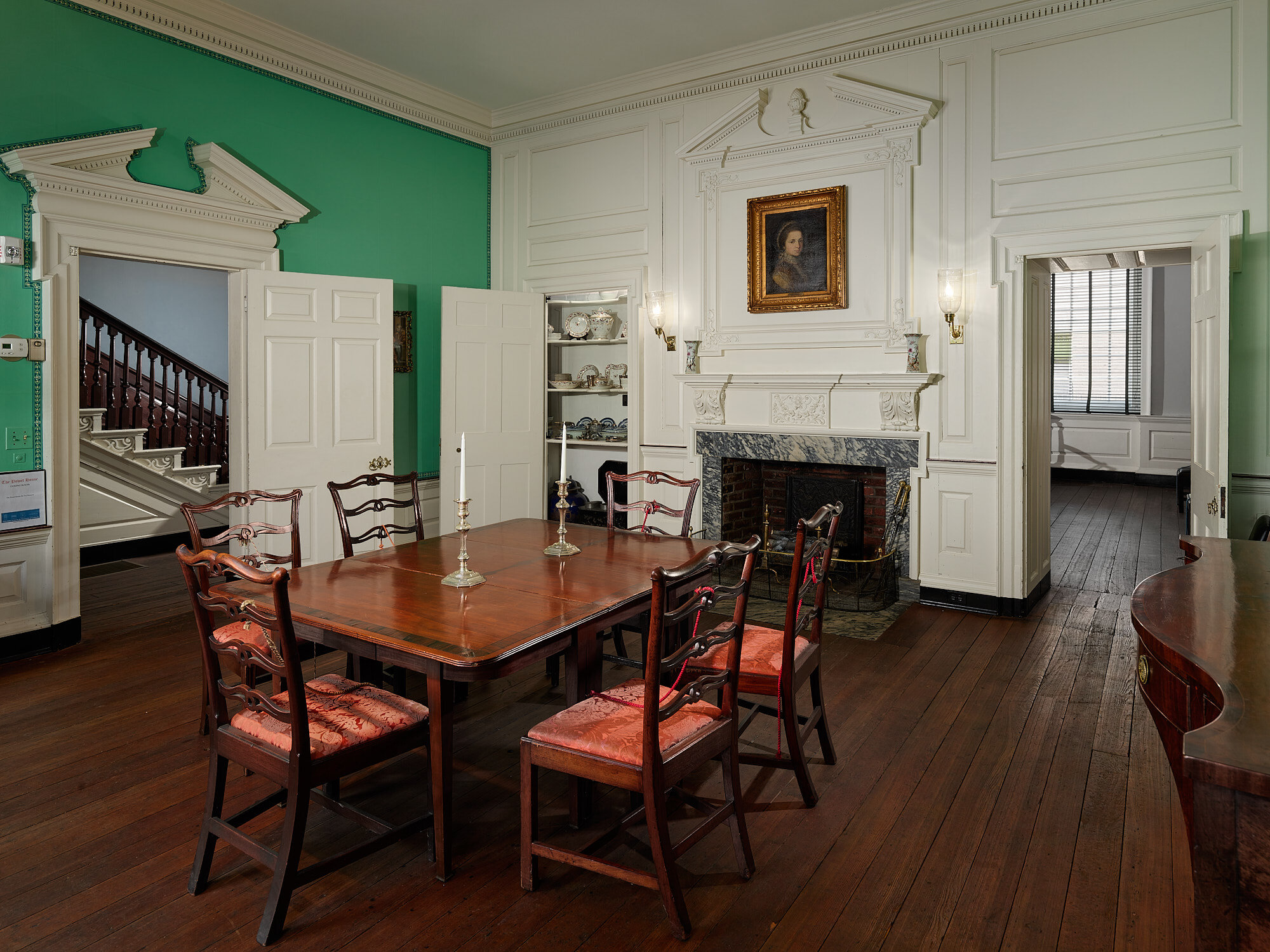
Photo by Joe Pulcinella
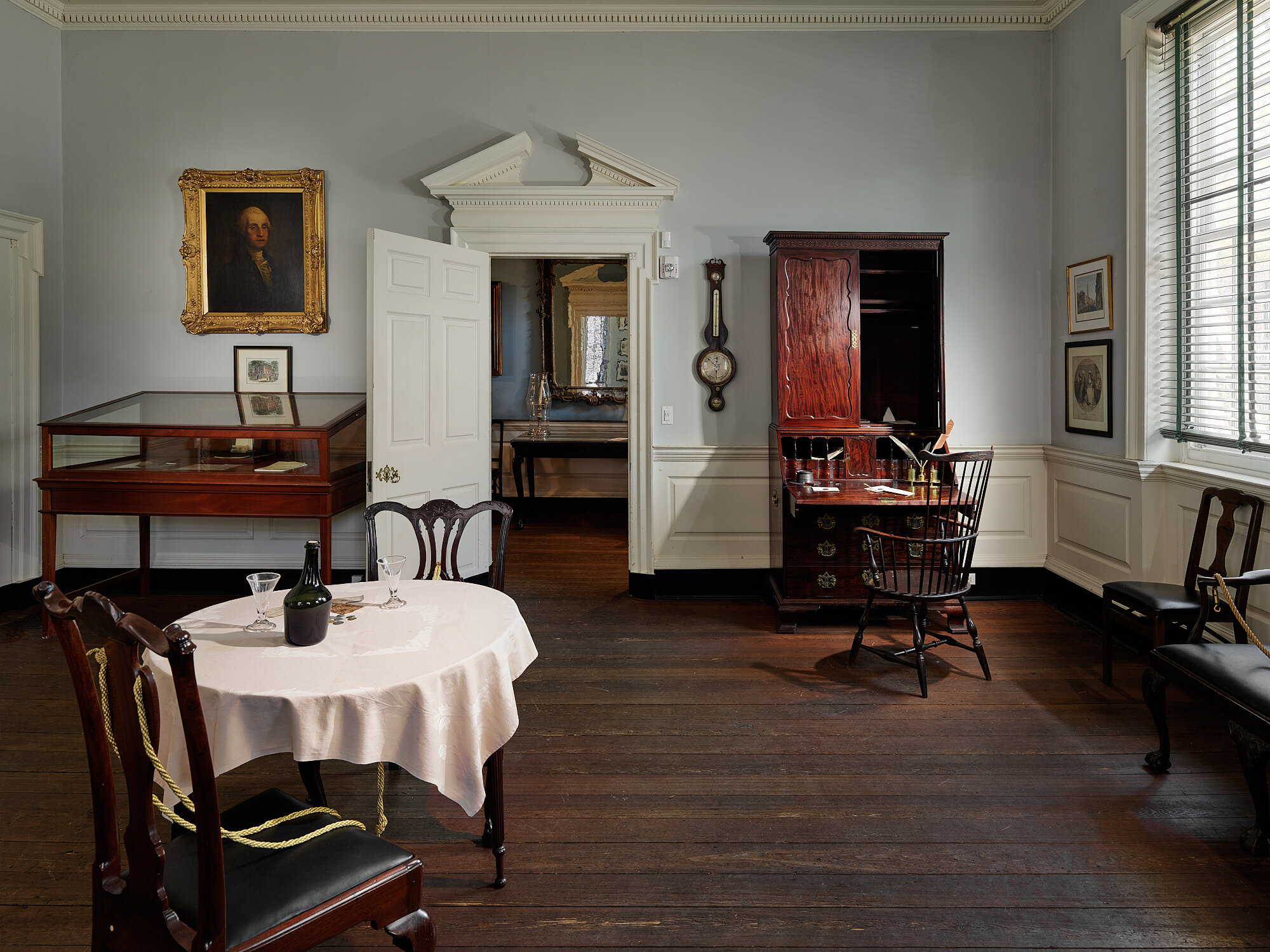
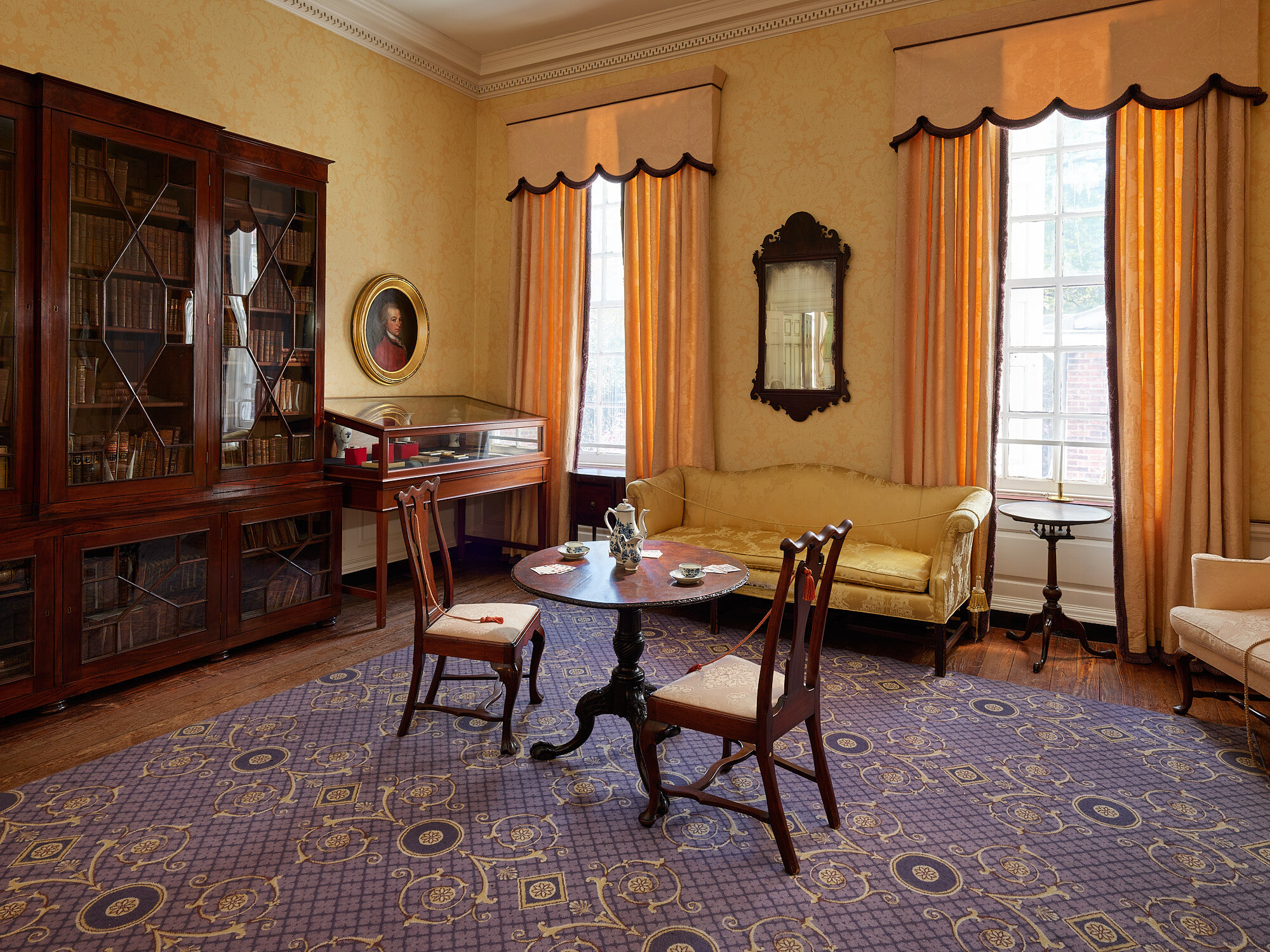
Photo by Joe Pulcinella
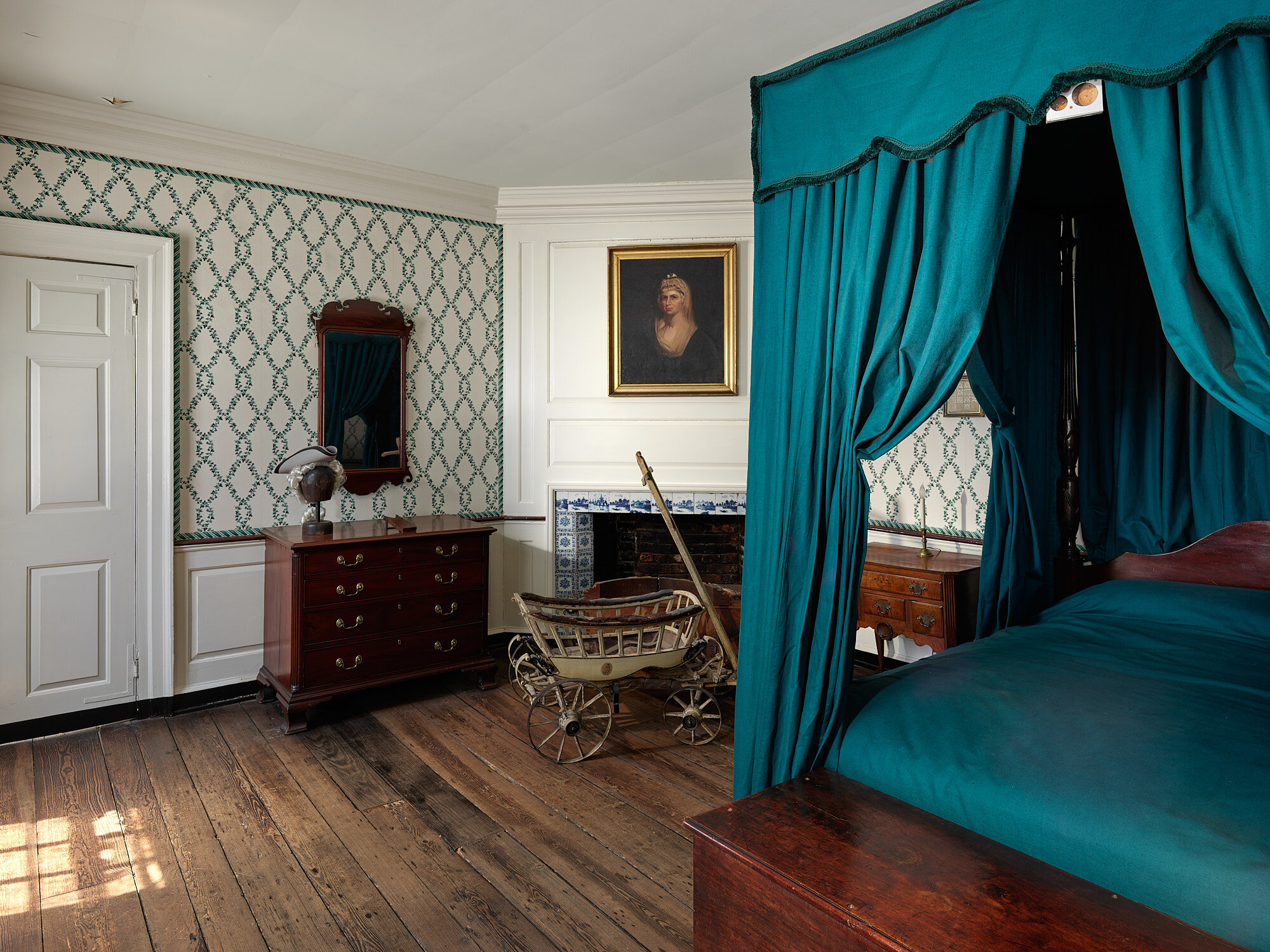
Photo by Joe Pulcinella
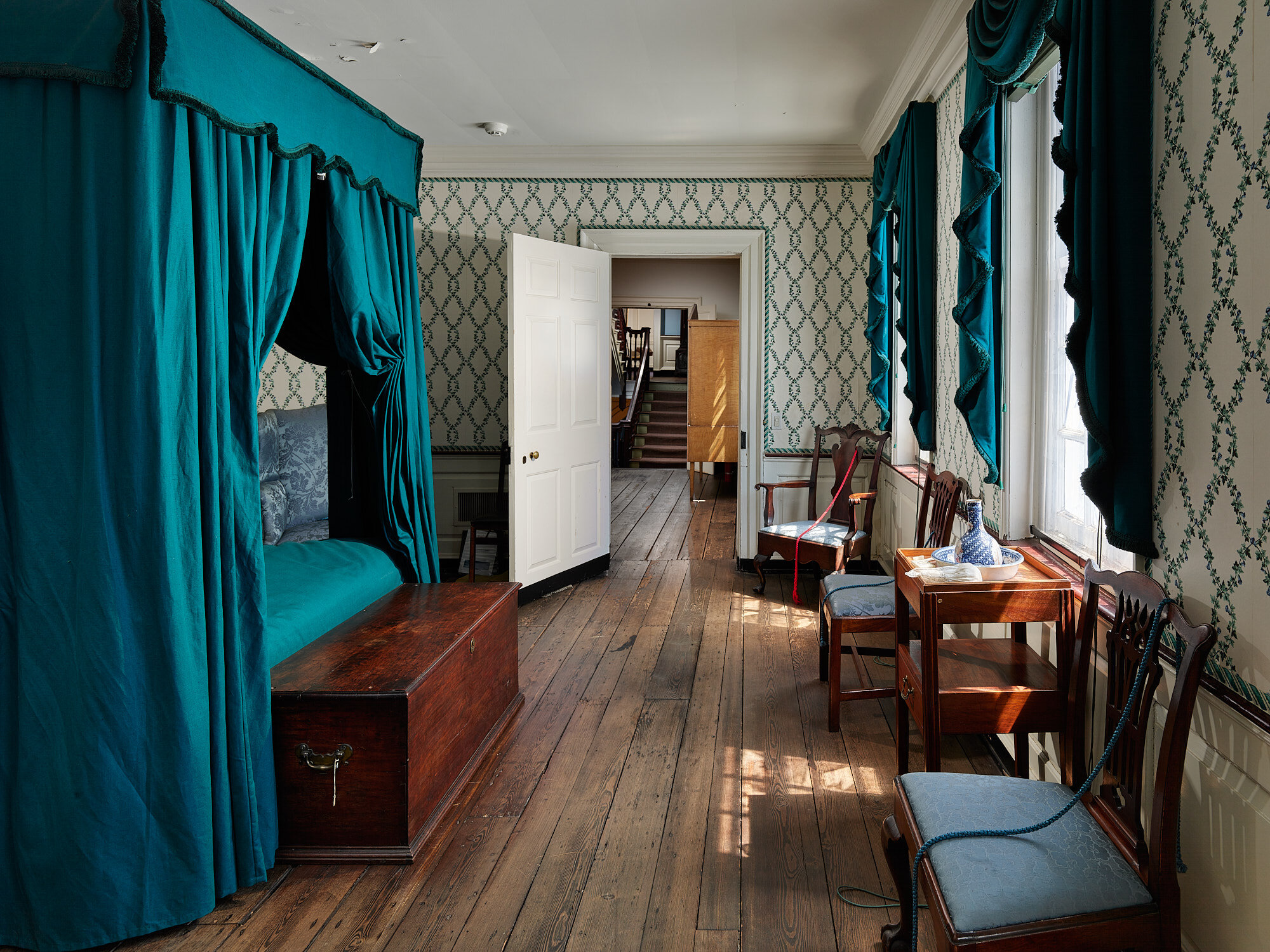
Photo by Joe Pulcinella
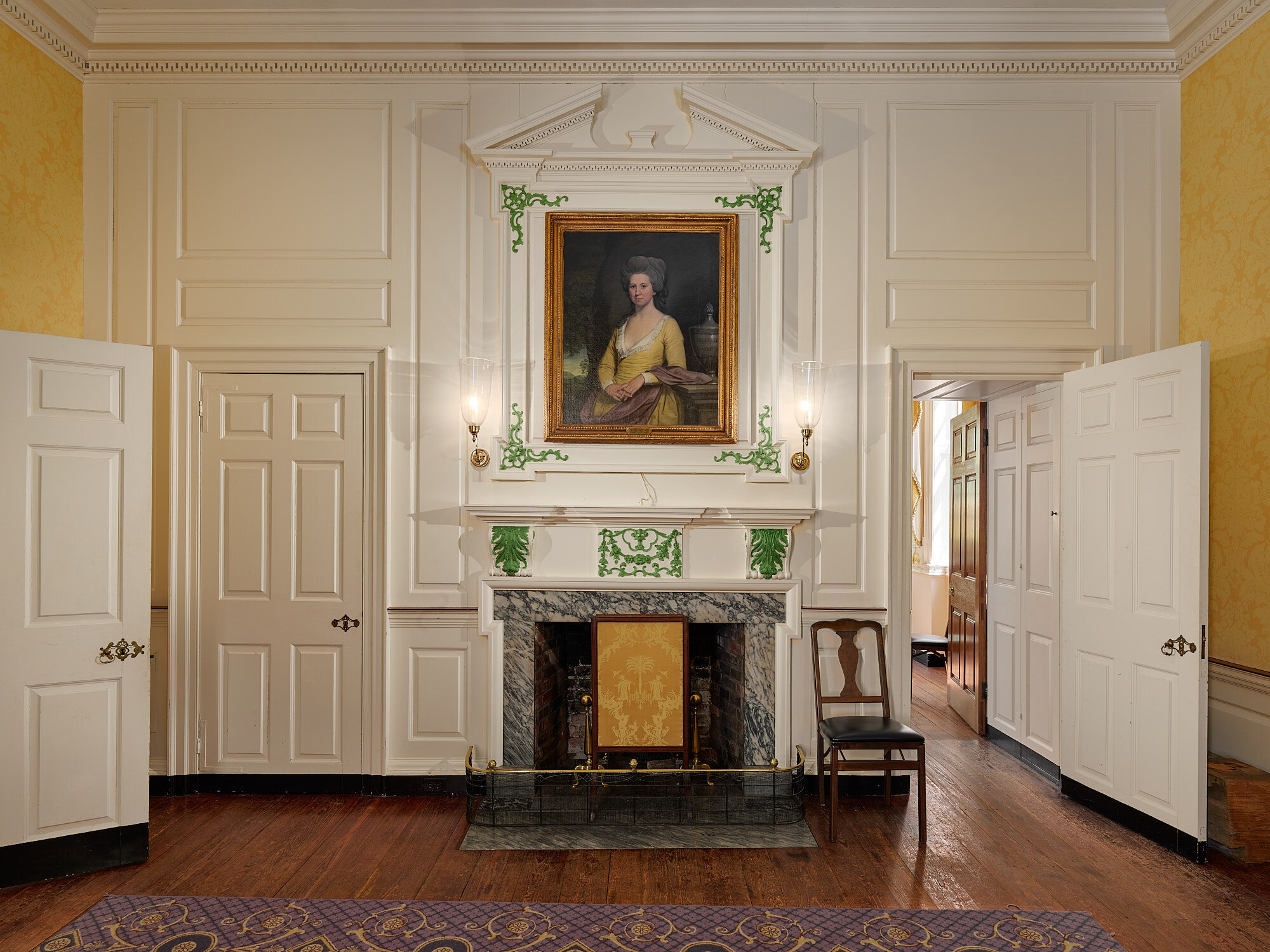
Photo by Joe Pulcinella
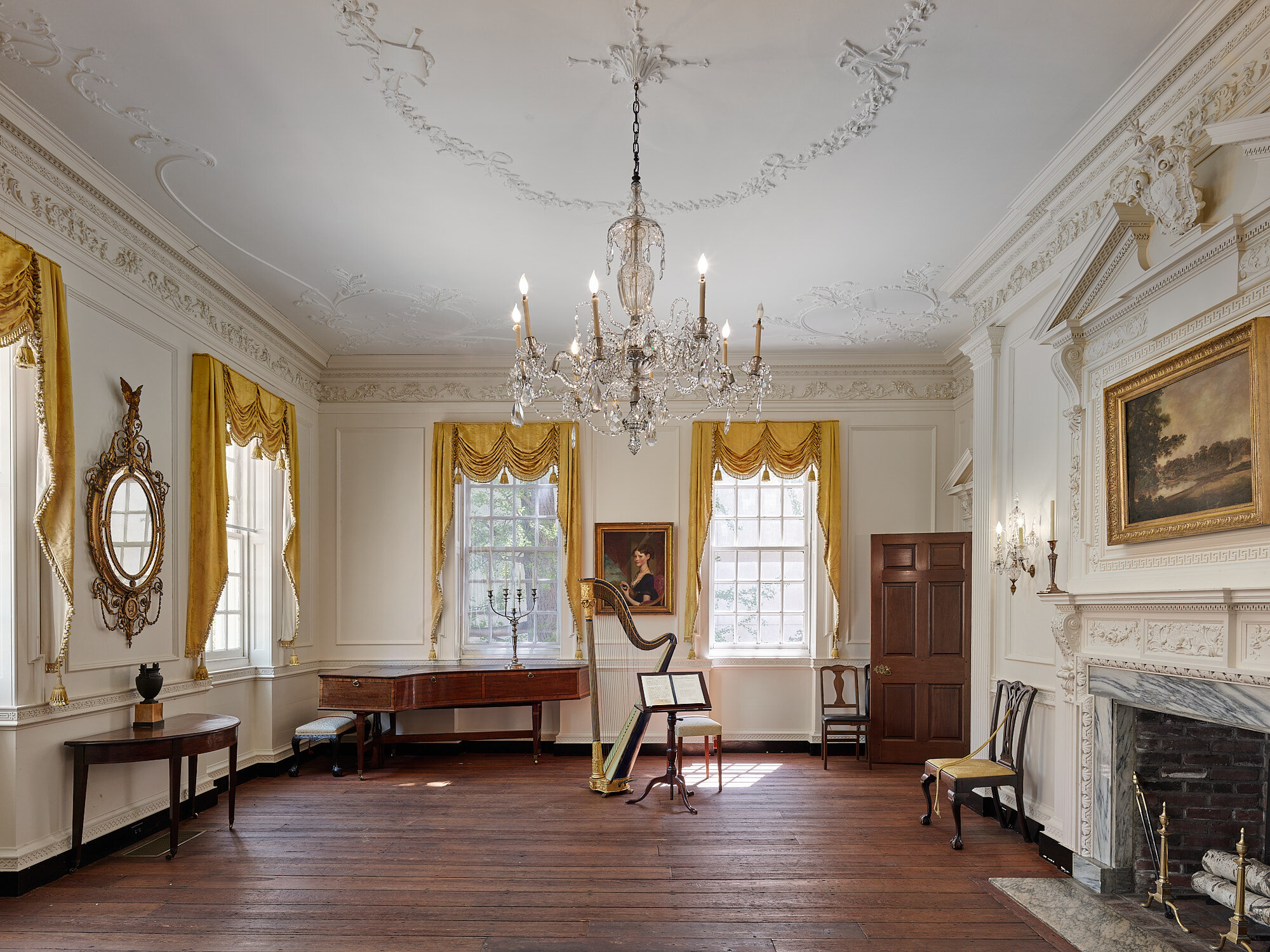
Photo by Joe Pulcinella

Photo by Joe Pulcinella
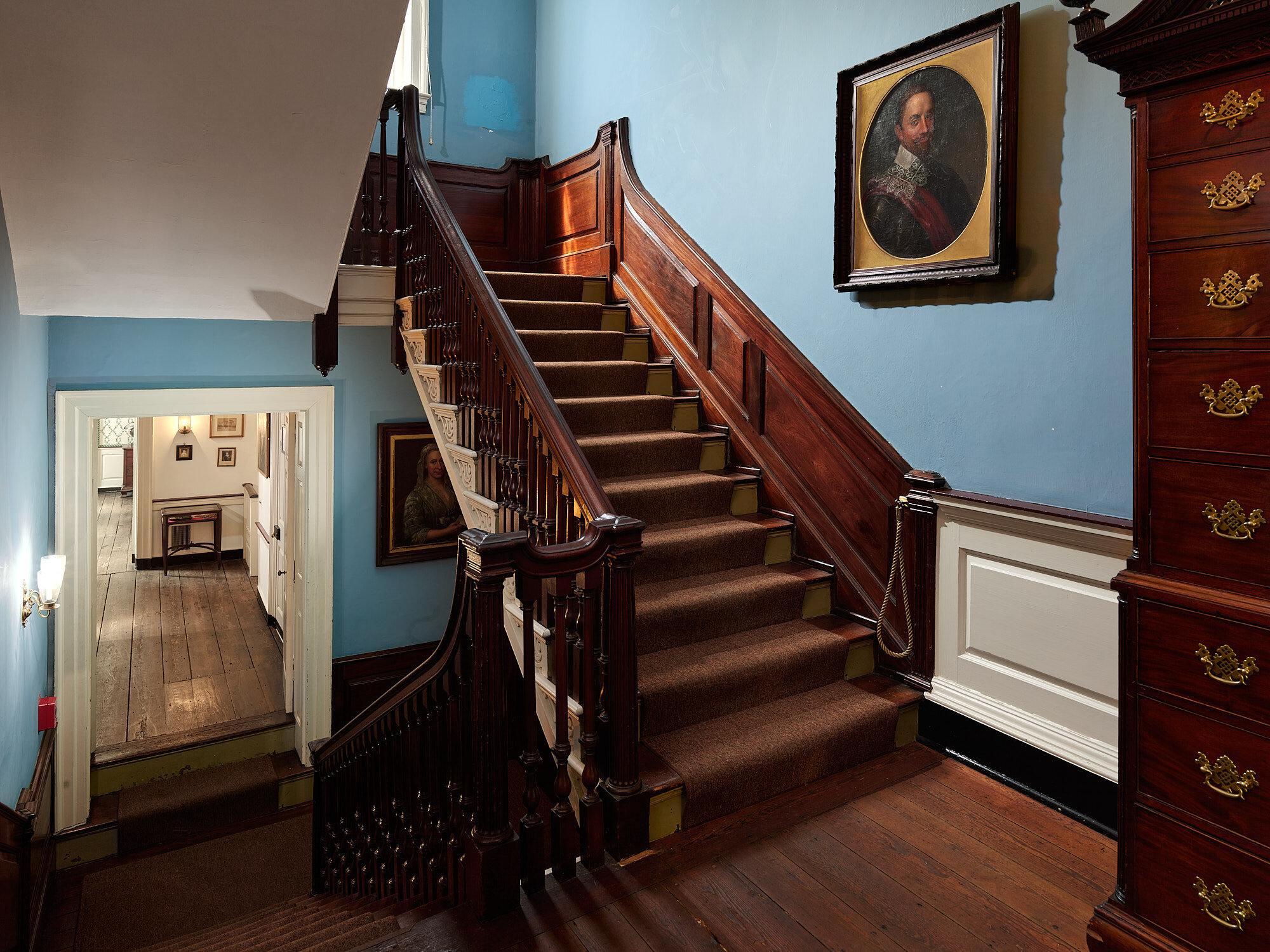
Photo by Joe Pulcinella
Powel House Rooms/Objects at Museum
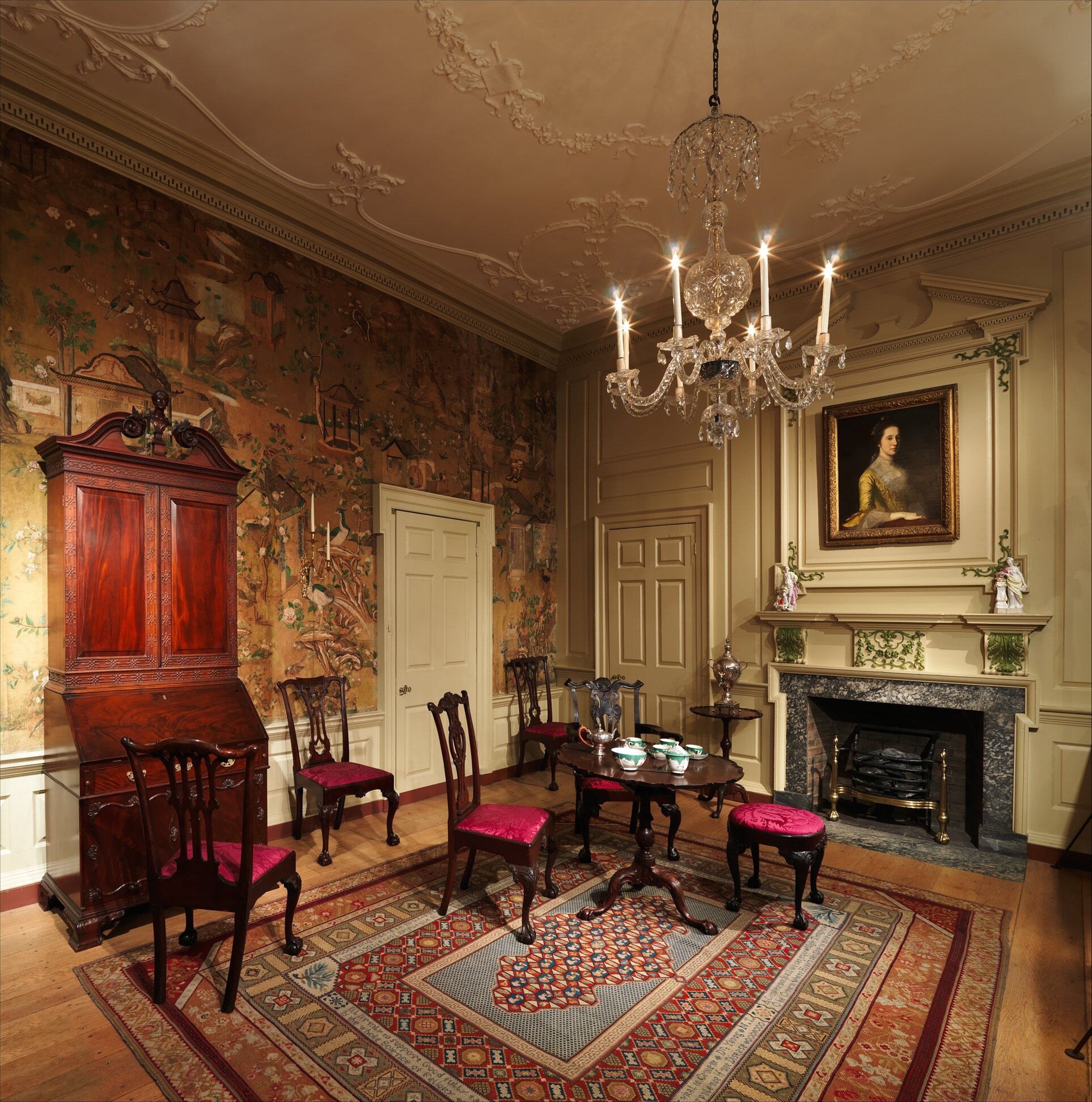
Metropolitan Museum of Art. American Wing. This room was on the 2nd floor, behind the ballroom. Courtesy of the Metropolitan Museum of Art.
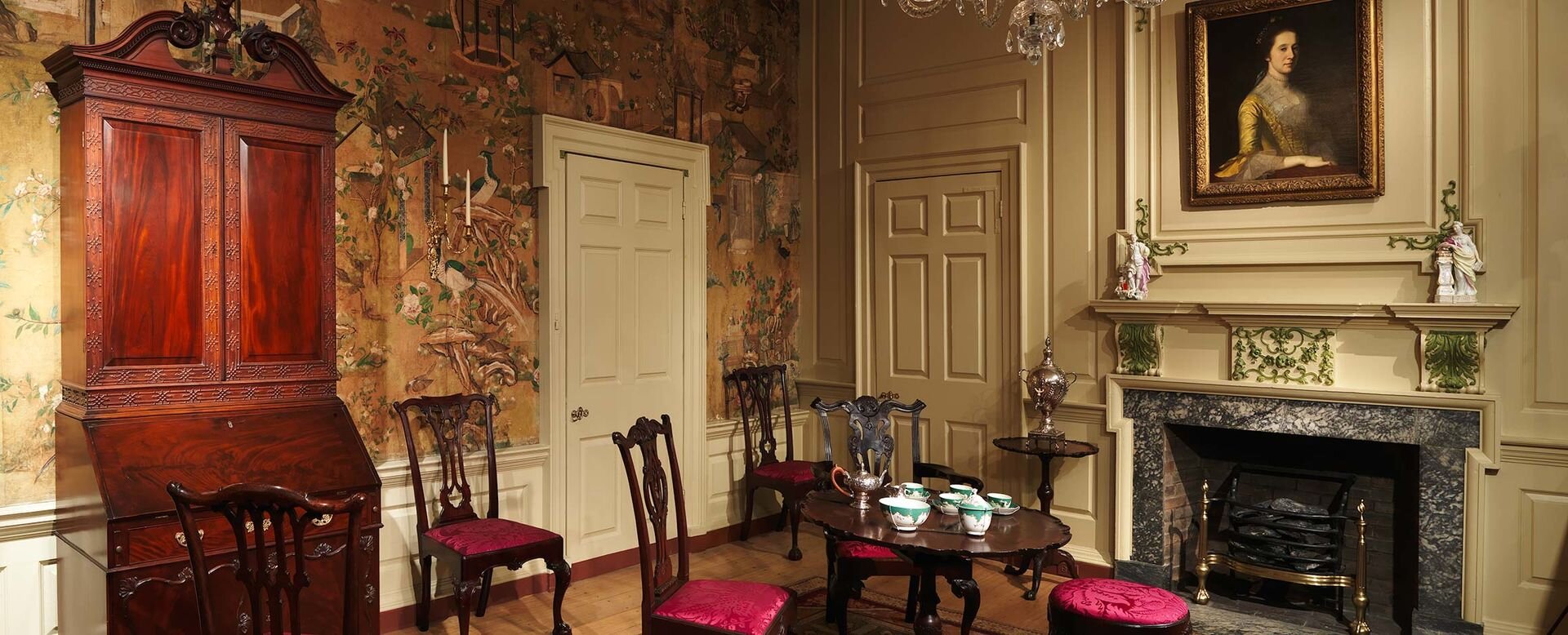
Powel House Period Room, Metropolitan Museum of Art. Georgian high style details: marble fireplace, crosseted overmantel with verdigris-painted foliate ornament. Courtesy of the Metropolitan Museum of Art.
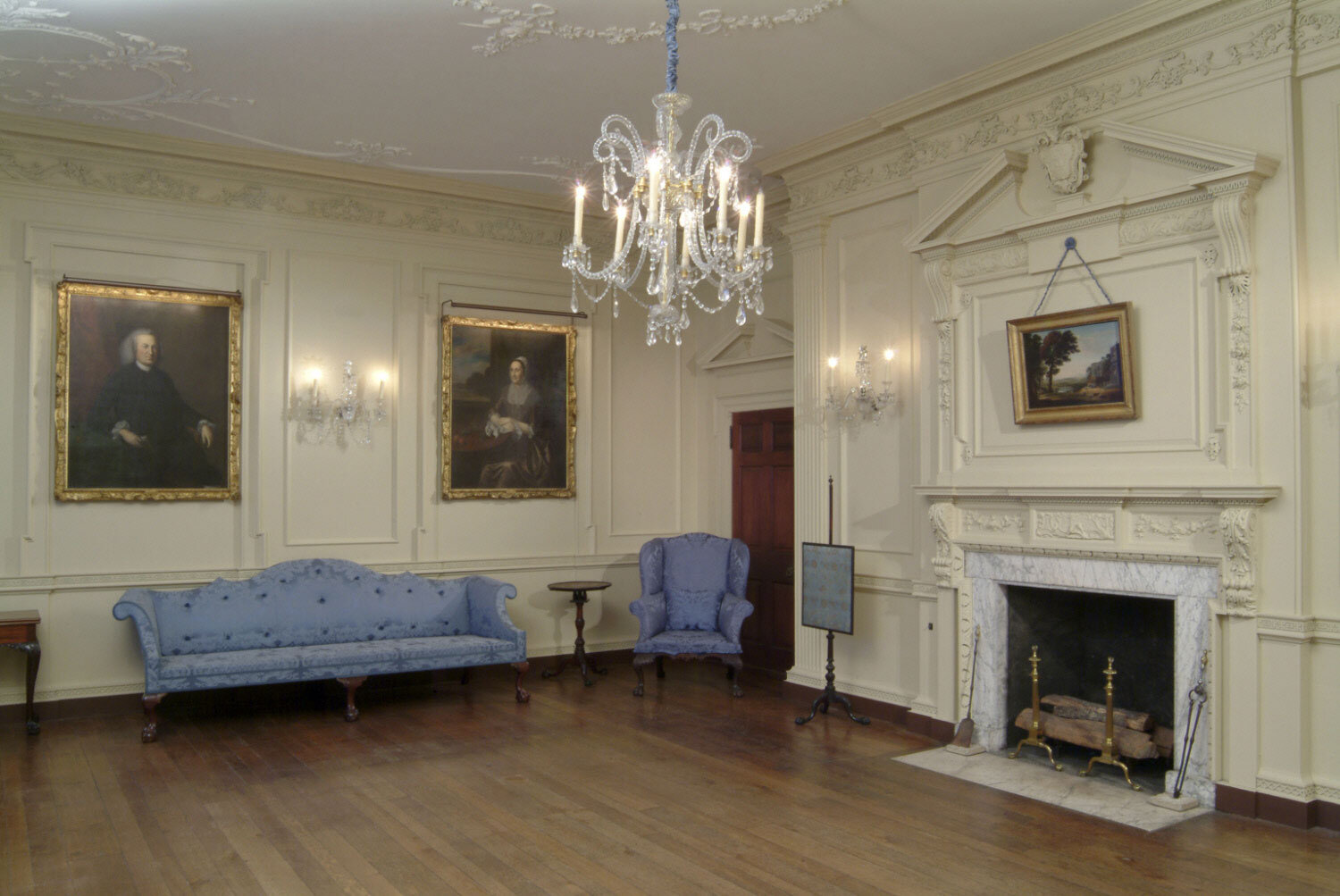
Powel House Period Room. Courtesy of the Philadelphia Museum of Art.
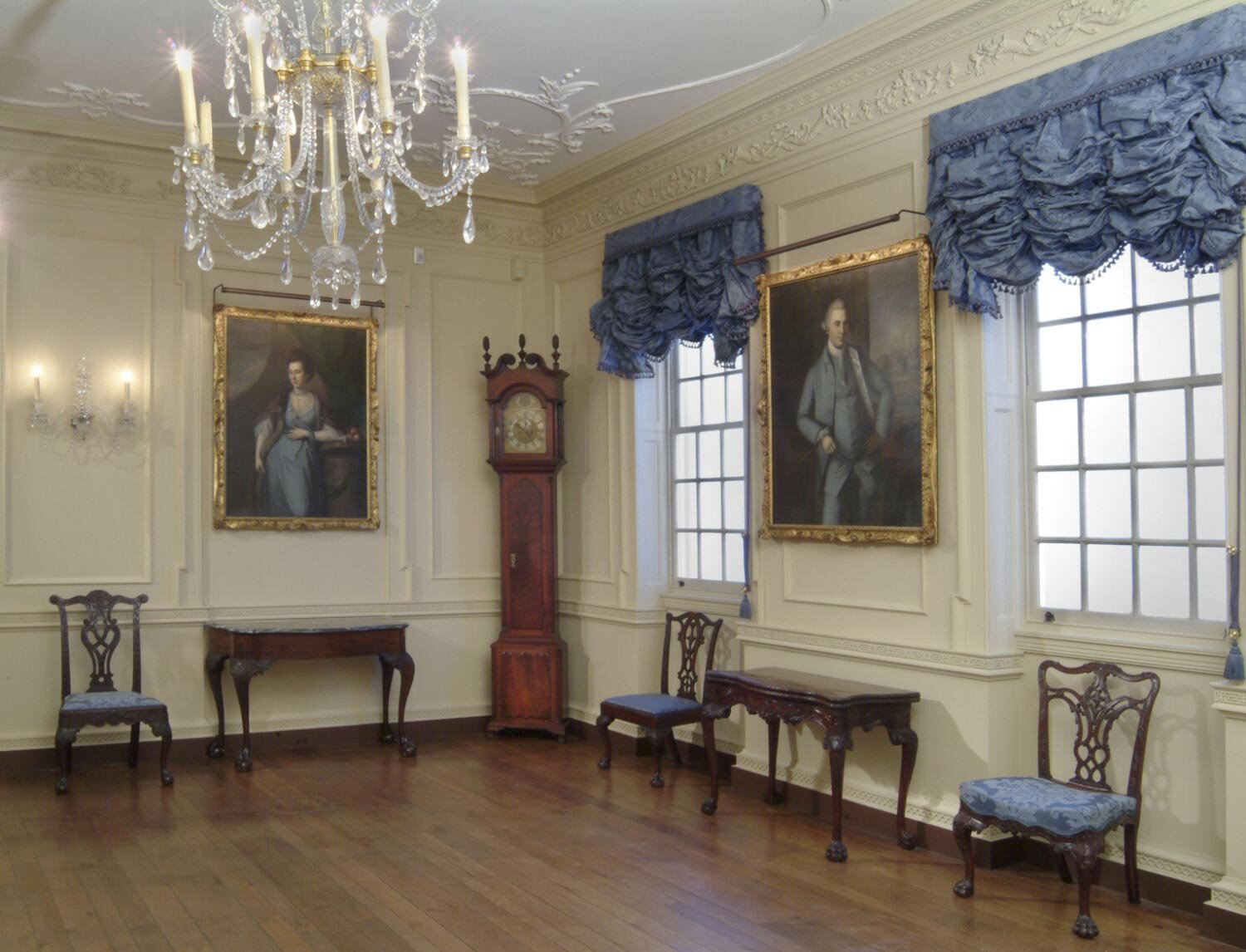
Powel House Period Room. Courtesy of the Philadelphia Museum of Art.
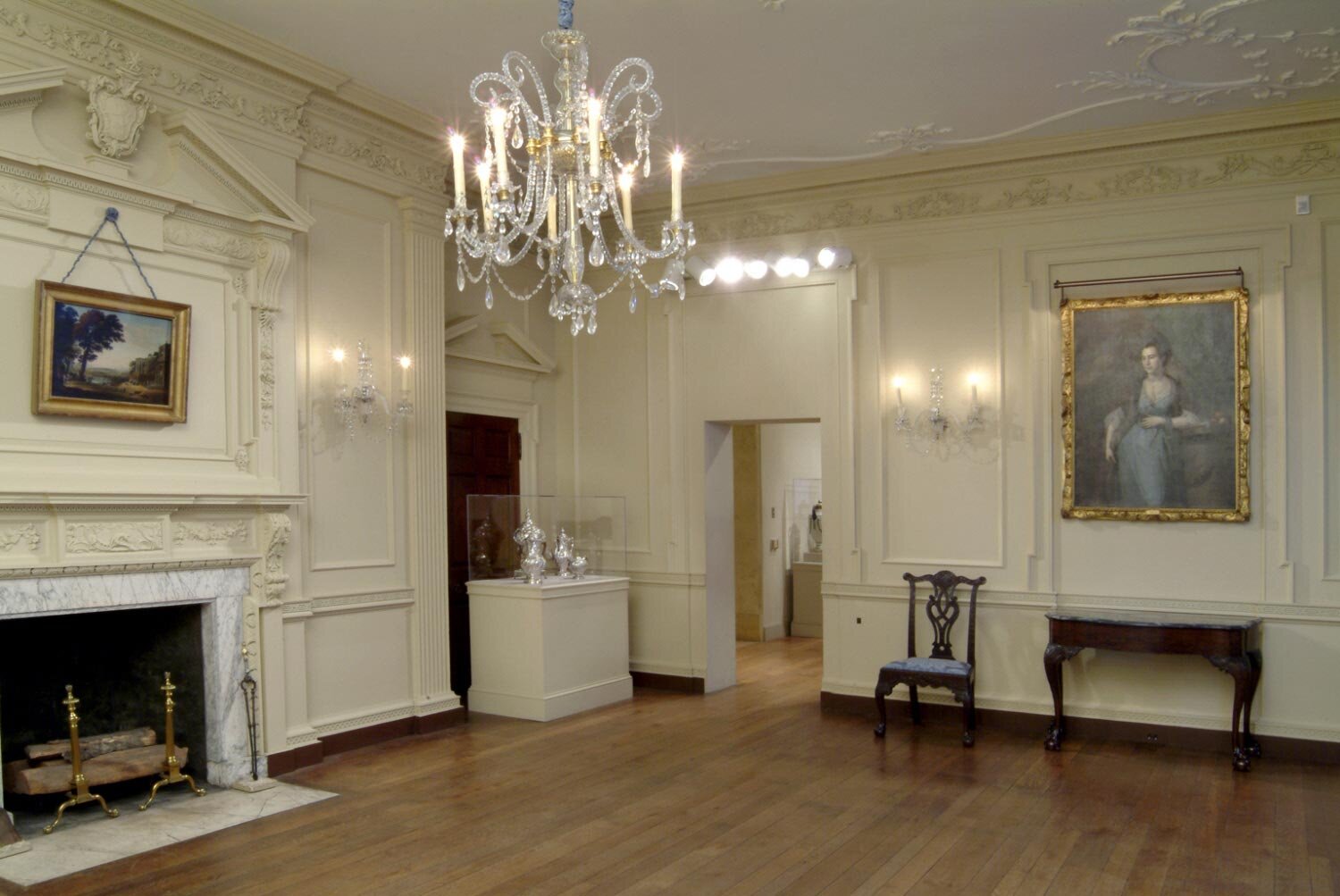
Powel House Period Room. Courtesy of the Philadelphia Museum of Art.
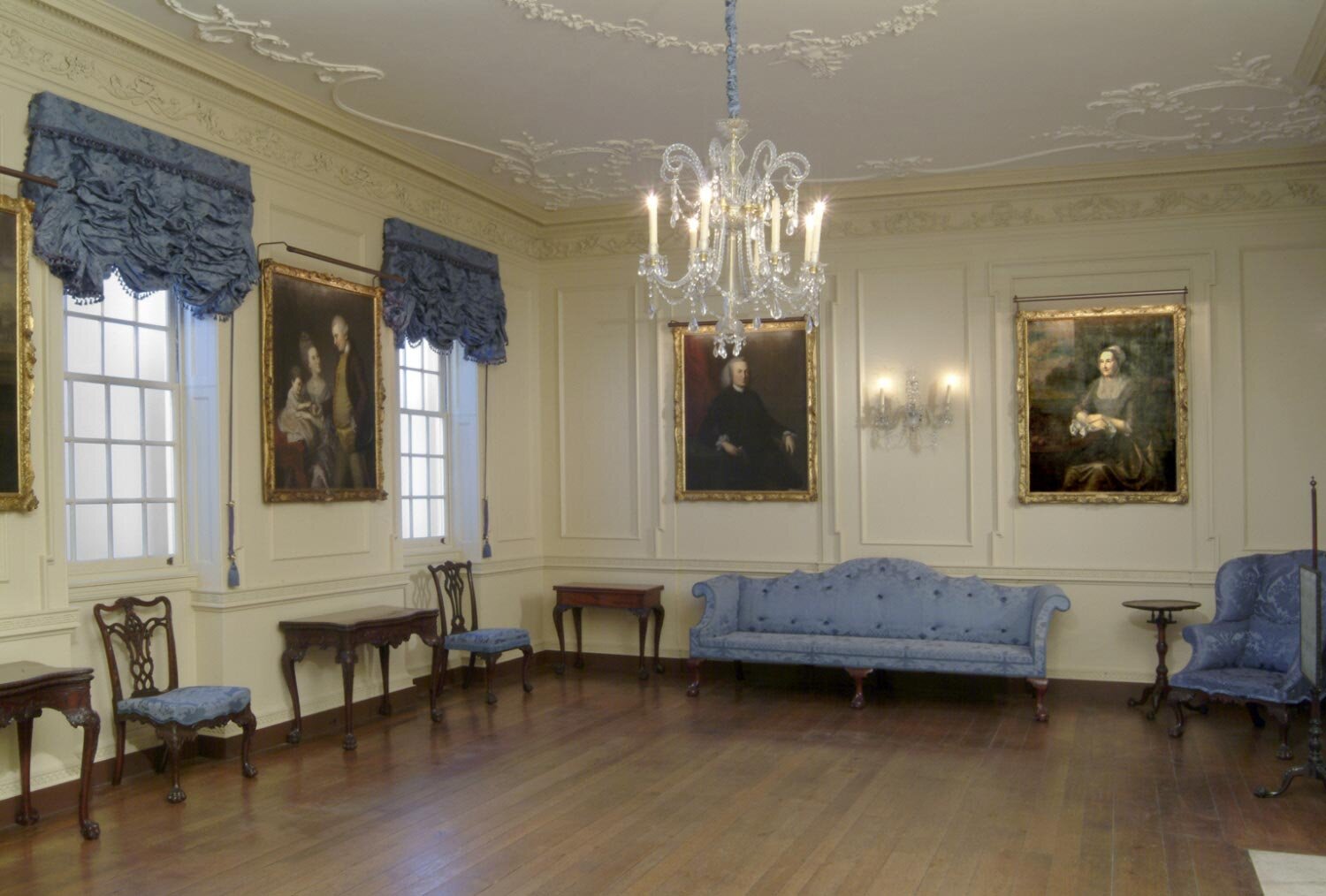
Powel House Period Room. Courtesy of the Philadelphia Museum of Art.

Powel Coach at Mount Vernon. One of only 6 historic American coaches in existence. Made by renowned Philadelphia Carriage Maker David and Francis Clark. Courtesy of the Mount Vernon Ladies' Association.

Powel Crest. Like today, vehicles were a mark of wealth. In 1772, only 84 Philadelphians owned carriages out of a population of 20,000. Courtesy of the Mount Vernon Ladies' Association.
Powel House Garden
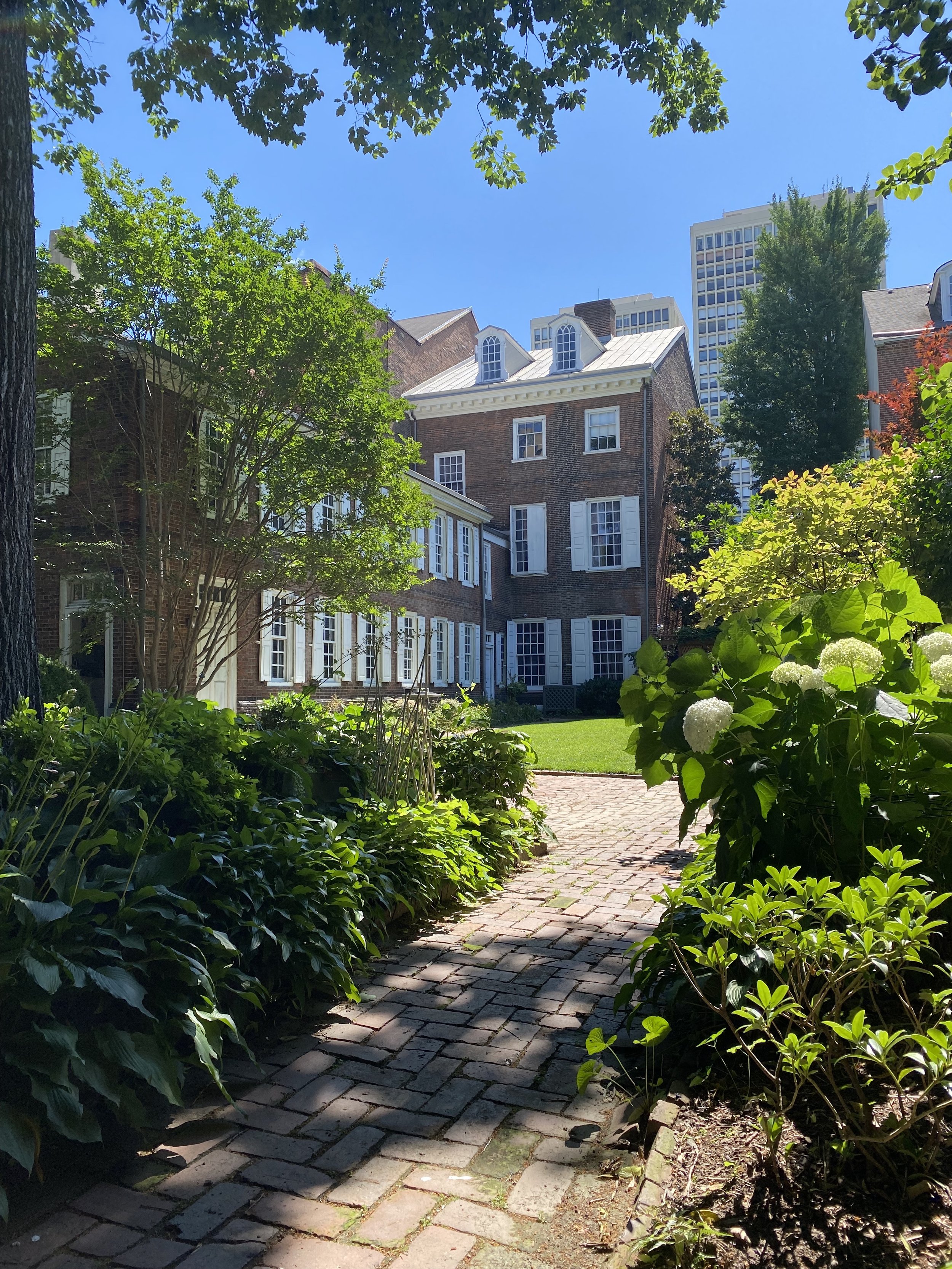



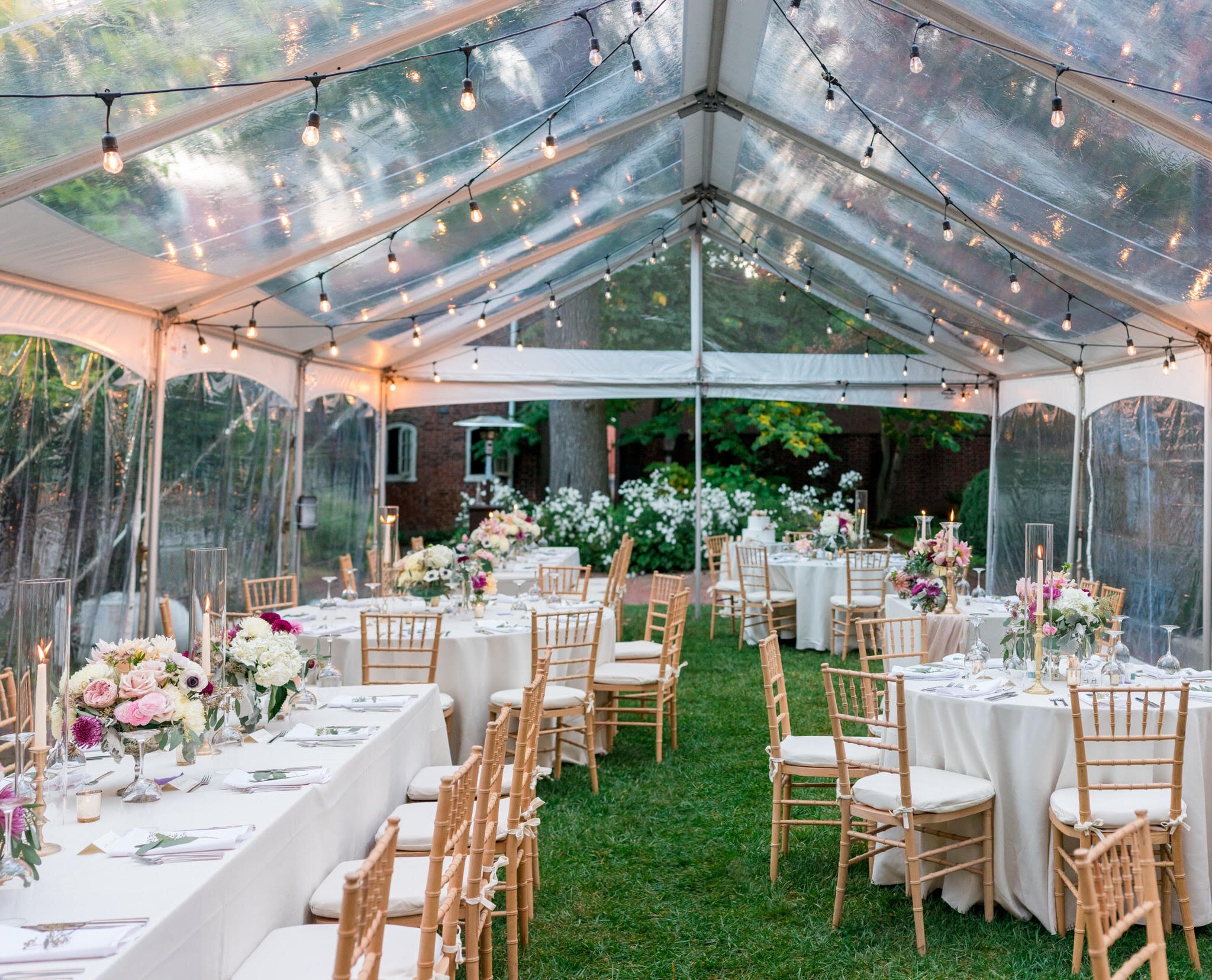

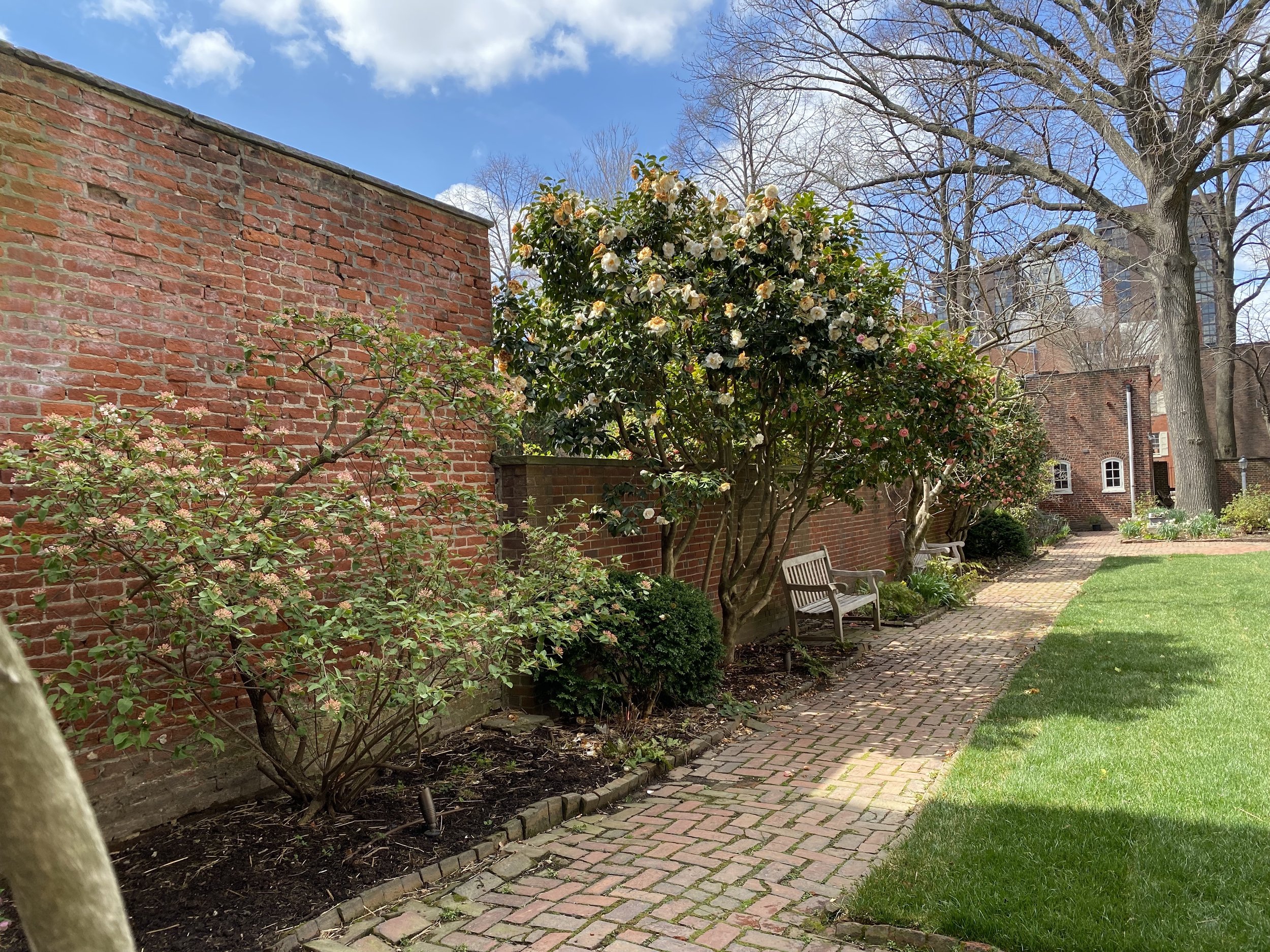


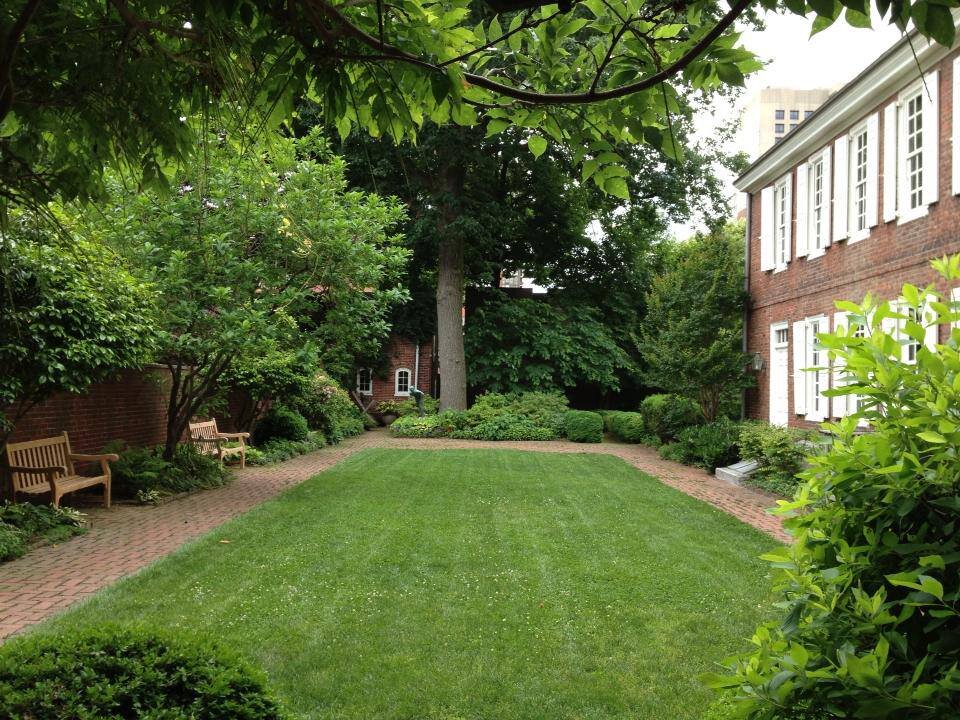





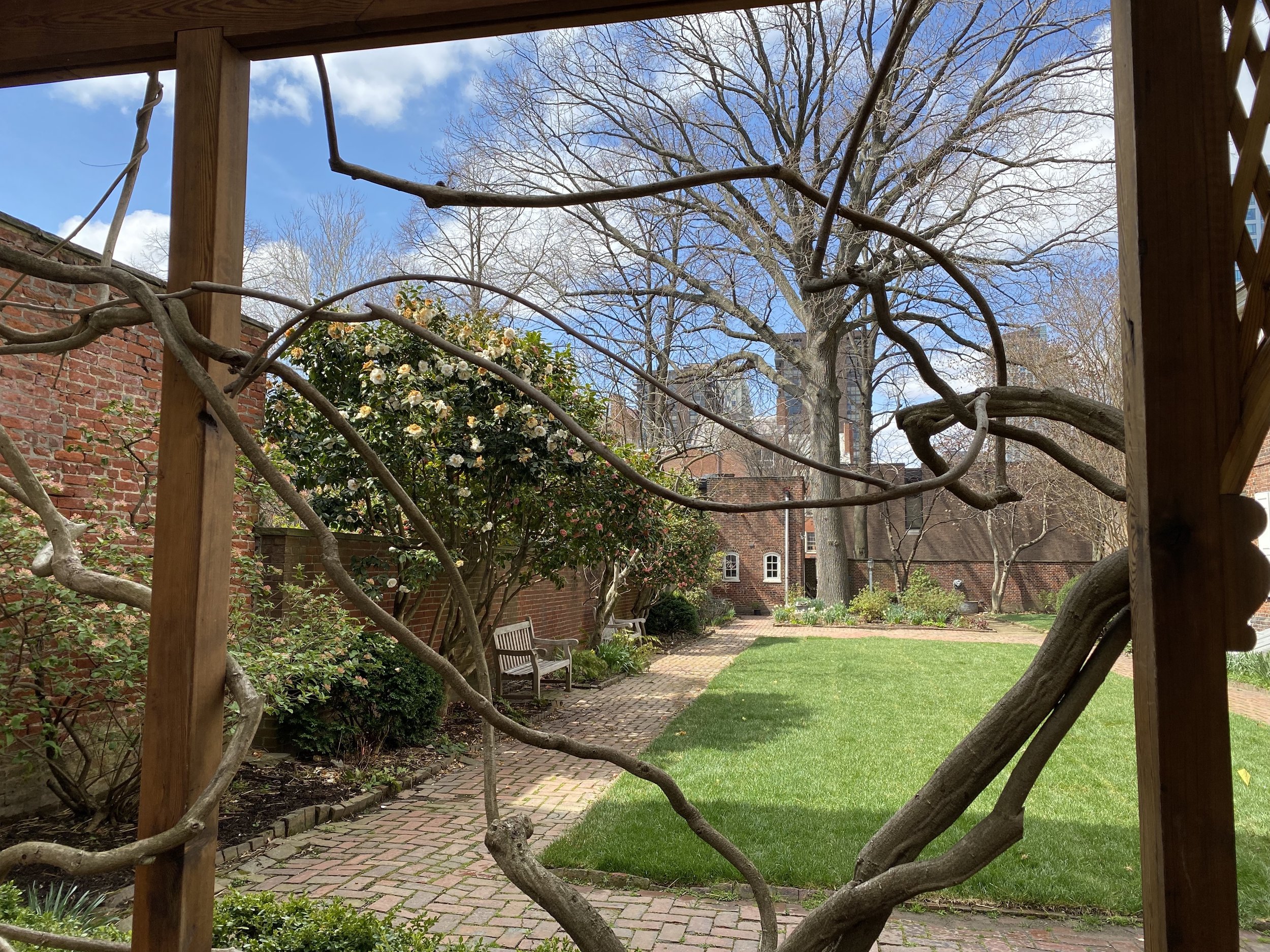
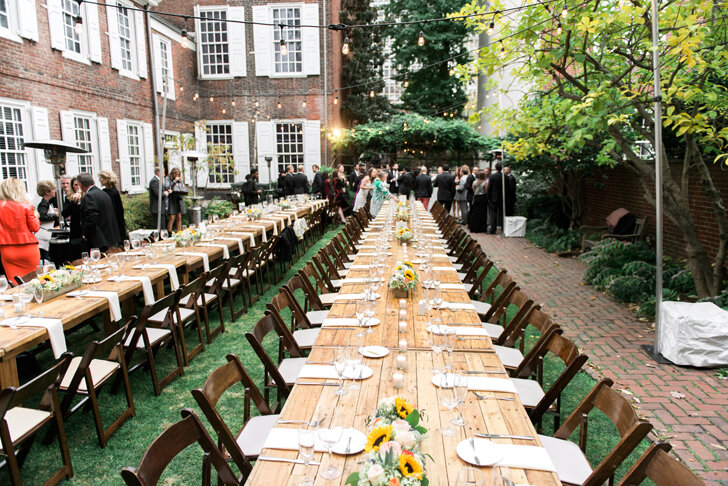



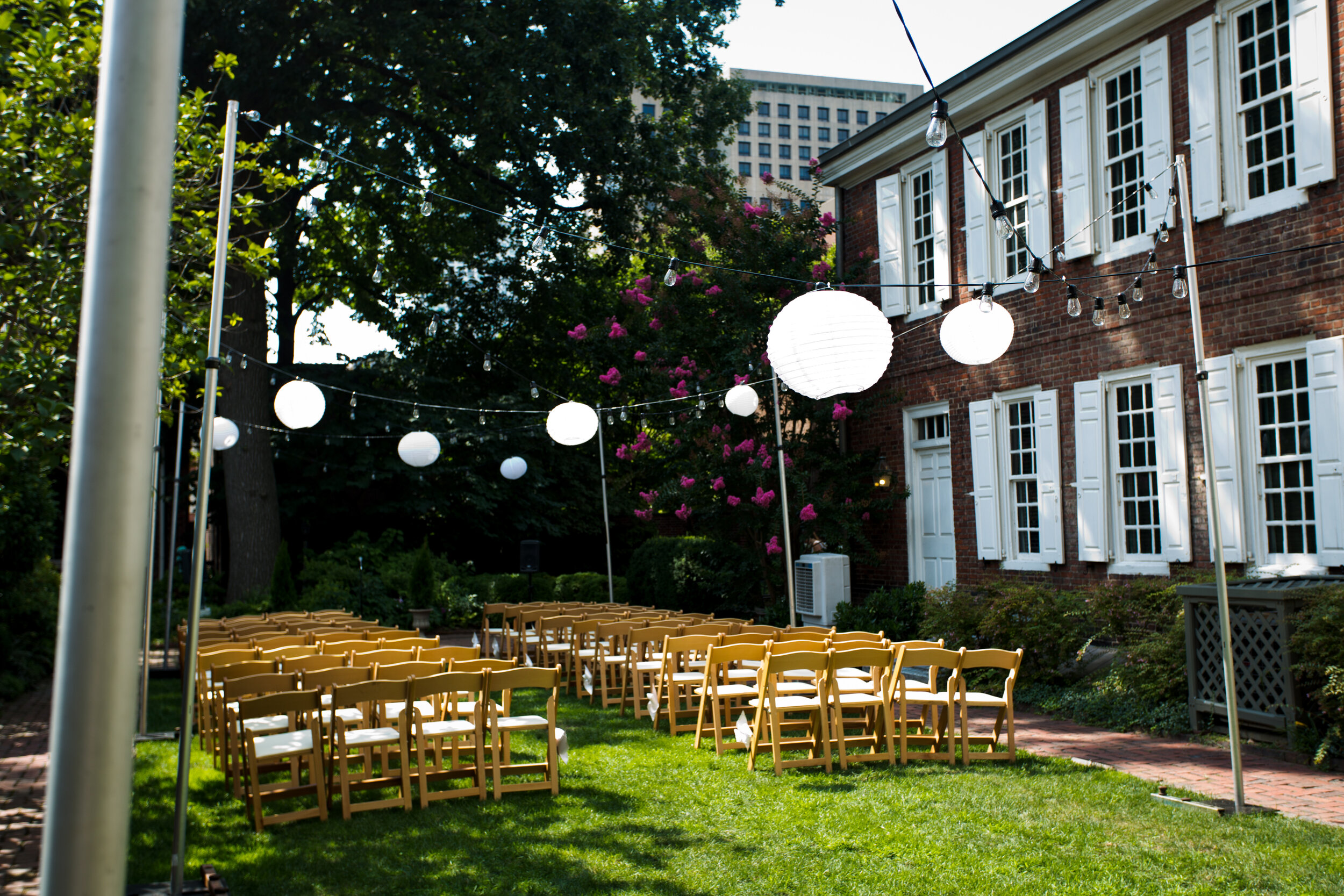

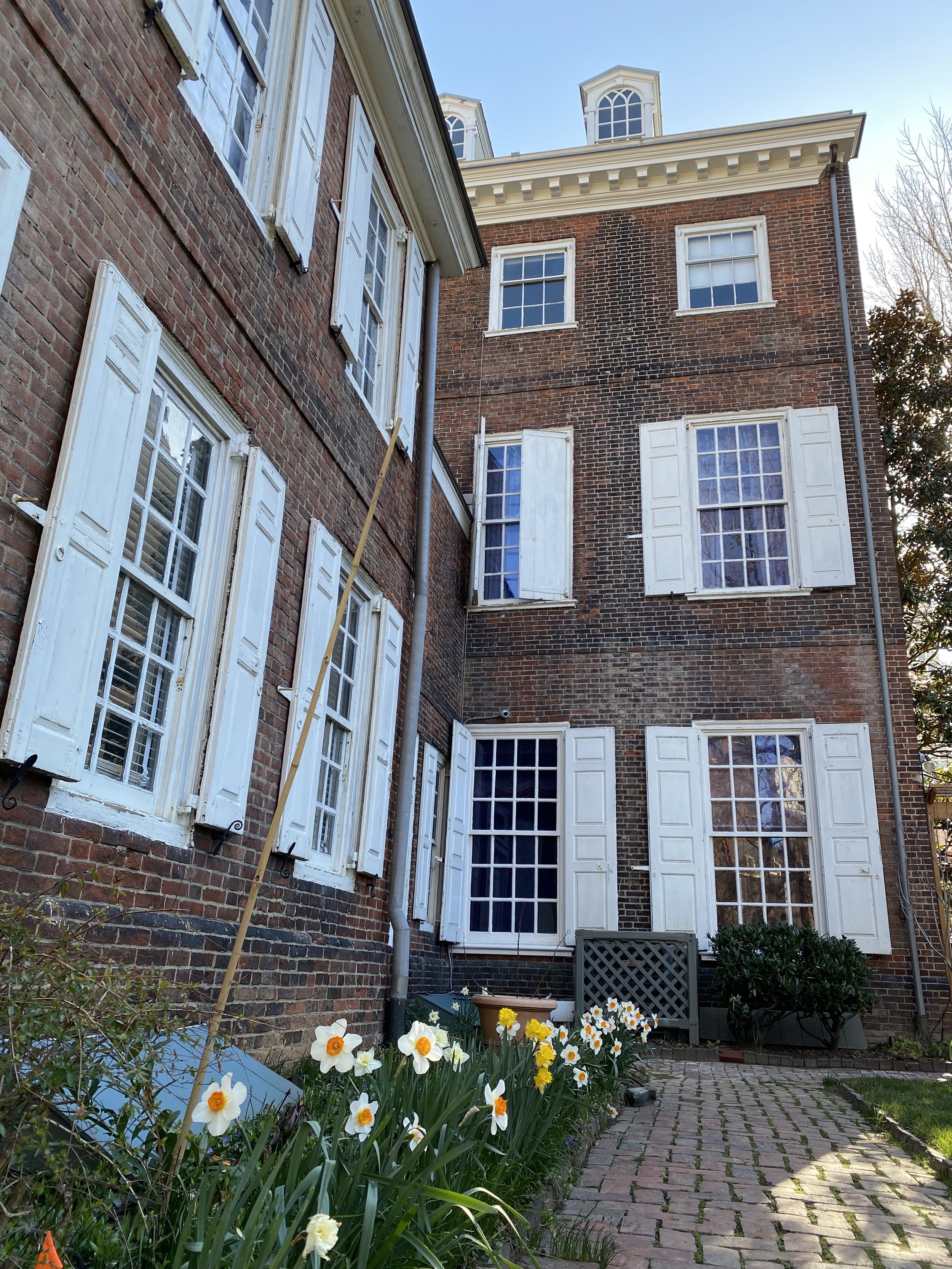






Samuel and Elizabeth Powel
Copy of Portrait by Angelica Kauffman, 1764-65, Philadelphia Society for the Preservation of Landmarks
SAMUEL POWEL (1738 - 1793)
-
Samuel Powel III was born on October 28, 1738, in Philadelphia, PA, to Samuel and Mary Morris Powel. Samuel and his two sisters were third-generation Philadelphians.
Samuel I. Samuel’s grandfather was the first of the Powel line to arrive in Pennsylvania in 1685. He married Abigail Wilcox in 1710, the daughter of Barnabas Wilcox from Bedminster, England. The couple would eventually have five children.
The Wilcox family was already prominent in Philadelphia when Samuel I first arrived. Abigail’s brother had been elected Mayor of Philadelphia in 1705.
Samuel I learned the building trades and constructed several bridges and the Philadelphia Court House. He then set up a prosperous merchant firm which also included a shipping business and began amassing great wealth. Samuel I was also a manufacturer of fire buckets.
The first generation Powels were among the earliest large landholders of Philadelphia. The family owned 90 houses and parcels of land within Philadelphia and its surrounding areas.
Samuel Powel’s father Samuel II (1704—1759) continued with his father’s businesses and successfully grew the family assets and holdings. Samuel II also entered into politics and was elected a councilman, and later advanced to alderman.
It was Samuel II who opted to drop the “L” in the family’s Welsh last name of Powell, and change it to Powel.
Samuel II died at age 42, when his son was eleven years old. As the oldest child of three, and the only surviving son, Samuel was heir to the substantial Powel fortune.
At sixteen, his mother enrolled him in the Academy and College of Philadelphia, which is now the University of Pennsylvania. Powel graduated in the college’s second class, with an A. B. in Philosophy.
When Powel’s mother died in 1759, Samuel, at the age of 21, inherited his family’s fortune, including the 90 properties.
With that new fortune, Samuel set out to enhance his knowledge and polish his social skill sets on a Grand Tour of Europe, alongside several of his classmates.
He traveled with his close friend John Morgan, who, after his return to America, founded Pennsylvania’s first medical school and served as Surgeon General in the Continental Army.
The pair ventured through Holland, Italy, France, and England. They attended concerts and balls, socialized with nobility, religious figures, and intellectuals, including Voltaire and Pope Clement XIII. The Pope received them on Easter with “great courteousness and affability.” John Morgan wrote in his diary that the Pope asked many questions concerning America.
Powel spent seven years abroad, arriving home in October of 1767.
-
On August 7, 1769, nearly two years after his return from abroad, Samuel Powel married Elizabeth Willing. The couple soon found their place in Philadelphia high society.
Just before the Powels’ marriage, Samuel purchased a home on South Third Street from Charles Stedman. The home was originally built in 1765.
He and Elizabeth hired Robert Smith as their builder and hired Philadelphia’s leading carvers and craftsman to decorate the principal rooms. James Claw likely created the elaborate Rococo design of the carved ceilings in the ballroom. Hercules Courtenay likely carved the exquisite ornamental mantle and overmantel, along with the cornices, paneling and baseboards. While Martin Jugiez and Nicholas Bernard, carved the beautiful mahogany staircase.
Samuel established his reputation as an elite gentleman through membership in various societies, and through serving in political positions. He was a member of the City Council, justice of the Philadelphia Court of Common Pleas, and Quarter Sessions courts.
In 1775, Powel was appointed mayor of Philadelphia, the last mayor under the royal charter of 1701. He served in that position for a year, until it was eliminated under the Pennsylvania Constitution of 1776.
He served as a vestryman and warden in the United Episcopal Churches of Christ Church and St. Peter’s. He was also appointed as one of the lay deputies for Pennsylvania for the first six Conventions of the Protestant Episcopal Church.
-
The Powels, like many other wealthy families, made gestures in support of the colonies and against the British government.
Powel pledged money to “the relief of the poor at Boston” after Parliament closed the city’s port to punish the city for the Boston Tea Party. Powel was also present at the State House on July 8, 1776 to hear the first public reading of the Declaration of Independence.
However, the Powels were quiet in their stance on independence from England as the war unfolded.
After their victory in the Battle of Brandywine on September 11, 1777, the British troops took Philadelphia from the Continental Army. The city was under British occupation until mid-June, 1778.
The Powels did not leave the city for the entirety of the occupation, unlike some of their family members and friends.
Samuel waited to see how the months unfolded, before finally signing his Oath of Allegiance to Pennsylvania in May of 1778. Elizabeth’s cousin Edward Shippen, and Samuel’s brother-in-law Thomas Willing signed at the same time, each acting as witnesses.
The Occupation of Powel House. The Powels’ home was occupied for two weeks by the the Earl of Carlisle. The Earl had come to America with a group of twelve other politicians on behalf of the crown, to negotiate a compromise of peace between the nations. This would later be known as the Carlisle Commission.
During this occupation, the Earl commandeered the Powels’ third floor lodgings. Ousted from their luxurious rooms, the Powels lived in a small bed chamber in the back wing of their home with their servants.
During his stay, the Powels were hospitable to the Earl. In his letters, the Earl wrote, the Powel’s drank tea with him every day, talked politics, and were the “best of friends in the world.”
Perhaps this friendliness was due to the significant risk they faced. Should it have become known to the Earl that Samuel Powel had signed the Oath to the Colonies in secret, the Powels may have suffered stricter consequences.
The Earl and his fellow negotiators were unsuccessful in their pursuit of ending the war at that time and eventually departed Philadelphia. In June of 1778, the Continental Army reclaimed Philadelphia.
A Decision Not to Serve in the Army. In March of 1777, a law had been passed in Pennsylvania that created a formal state-wide militia. With this law in place, all men between the ages of 18-53 were automatically enrolled in the militia, in a specific battalion in their city or region.
For those who chose not to actively participate, there was a steep fine. Samuel chose to pay the fines, as documented in his receipt books. He paid a total of £218 for “non Association militia fines,” between the years 1779-1785.
Financial Contributions to the Continental Army. In 1780, as a public show of support to the cause, Samuel Powel donated £5,000 for supplies for the Continental Army.
At the same time, Elizabeth donated £200 to the Ladies Association of Philadelphia, the first all women fundraising organization in the United States. This association raised nearly £300,000 in support of the Continental Army.
-
Samuel Powel was a member of numerous civic, philanthropic, and intellectual societies in Philadelphia.
Just after his return from Europe, Samuel was appointed as the Vice President of the American Society for Promoting Useful Knowledge. This short-lived organization was combined with the American Philosophical Society (APS) in 1769. Samuel stepped down as Vice President, but still continued to hold a membership to the APS until his death.
Powel would later serve on the Board of Directors of the Library Company, which he and subsequently Elizabeth held a share in until 1803, when Elizabeth passed the share on to her and Samuel’s nephew, Samuel Powel Griffitts.
In 1773, Powel was elected as a trustee of the College of Philadelphia, his alma mater, serving in the role for twenty years. He spent two years as its treasurer during the Revolutionary War.
Powel’s interest in agriculture and science led him to help organize the Philadelphia Society for Promoting Agriculture, serving as its first president from its founding in 1785 to his death in 1793.
As for charitable organizations, Samuel and Elizabeth both held separate shares in the Philadelphia Dispensary for the Medical Relief of the Poor, which was established in 1786. This organization was one of the first which allowed women to subscribe under their own name.
They are both on the list of the first fifty-two subscribers. Samuel had previously served on the board of Managers of the Pennsylvania Hospital from 1778-1780.
After a number of years focused exclusively on business and not serving in any government position since his term as mayor in 1775, Samuel ventured back into city and state politics.
He was elected the first Mayor of Philadelphia under the new Charter in 1789 (the office was vacant between his first term and subsequent second term), serving one term before being elected as a State Senator in 1790.
Powel again was chosen by his peers for a leadership role, serving as Speaker of the State Senate from 1792 until his untimely death in 1793.
-
A Broad, Worldly Education. After Samuel Powel graduated in 1759 from what is now the University of Pennsylvania, he embarked on a trip to England to raise money for his College. Powel had been selected to be a representative for the graduates of the College. And his trip included a meeting with King George III.
Powel then proceeded on a Grand Tour of Europe, spending seven years visiting Italy, Switzerland, France, England, and Scotland, meeting with scholars, Voltaire, the Pope and other notables.
These experiences abroad matured Powel and broadened his capabilities beyond the business skills he had acquired from his father and grandfather who were expert in the shipping, trading, building and real estate trades.
A Natural Leader. Powel’s skills, judgement and business success together with his ability to take charge led others to look to him to lead. Hence the many leadership positions Powel held through-out his life, all of which enhanced his capabilities in business.
What’s more, the business records Powel left behind are further evidence of his broad business savvy and attention to detail and why others had such confidence in him. The wide range of records that remain available for study include land-related papers (deeds and surveys), legal materials (wills etc;) and other financial records.
Developing and Adding to his Holdings. Powel rented out his properties and continually made repairs to their exterior and interiors to enhance his profits.
He also added to his holdings. Rather than reside in one of his Philadelphia properties, he instead purchased a recently built home on Third Street, which he and his wife Elizabeth then completely renovated. With his extensive knowledge of the building trades, Powel hired the finest craftsmen in the city to transform the house (and its value) into a masterpiece of high Georgian elegance.
Powel purchased 97 acres on the west side of the Schuylkill River in 1775. Powel bought the land from his wife Elizabeth’s brother, Thomas Willing, and her brother-in-law Tench Francis. Powel developed this into a working farm, producing numerous crops and raising livestock.
-
The Philadelphia Society for Promoting Agriculture. Having acquired a new country property, Samuel Powel developed a passion for agriculture. He soon found himself leading the effort to found the Philadelphia Society for Promoting Agriculture. Because of Powel’s extensive connections, he was key in helping Maryland based planter John Beale Bordley gather a group of 23 men interested in forming an American-based, science-driven agricultural society.
Members included George Washington, George Logan, Dr. Benjamin Rush, Richard Peters among others.
The Society played a key role in developing farming practices that have enabled our country to become the bread basket of the world, including crop rotation, soil fertility, harvesting and the breeding of livestock.
Powel became the Society’s first President and continued in that office until his death in 1793. We know how important Powel’s support, charisma and leadership must have been to the Society, as its activity slowed considerably for several years after his death.
The Society’s influence was responsible for the establishment of Pennsylvania State University, the School of Veterinary Medicine at the University of Pennsylvania, and the United States Department of Agriculture. Organized in 1785, it is oldest agricultural society in the U. S.
The Evolution of Powelton. During the early years of his ownership, Samuel Powel built a small house on his country property for a tenant farmer. Sadly, this is where Samuel spent his last days during the Yellow Fever epidemic of 1793.
Several years after Powel’s death, between 1800—1802, his wife and sole heir Elizabeth Powel opted to build a larger house that she could use a summer home. She oversaw the project personally and named her new country mansion ‘Powelton House.’
In 1816, Powel’s nephew and future heir John Hare (Powel), moved to the home to manage the farm for his aunt. Once he married Julia De Veaux she joined him there and they began having children.
In 1825, Hare Powel hired the acclaimed architect William Strickland to design a far more imposing Greek Revival mansion, a new Powelton. Strickland's additions likely included the Greek Doric colonnaded portico and the large scale wings on either side of Elizabeth’s house.
After all the work and effort, John Hare Powel never inhabited the finished house. He sold it in 1851 to the Pennsylvania Railroad Company. The house was torn down in 1885.
Powelton is now considered one of the finest buildings of the period. It was one of the architect William Strickland’s only private commissions.
All that remains of the mansion is the name Powelton, which today describes the surrounding neighborhood, Powelton Village.
-
Yellow Fever Arrives. In mid-August of 1793, with the federal government based in Philadelphia, yellow fever arrived on a ship from the West Indies.
Yellow fever was one of the most feared, virulent diseases of the time. Unlike smallpox, there was no understanding of its origins or effective way to inoculate against or treat this disease.
That spring had been unusually wet and the summer exceptionally hot with little rain, so the water in the Delaware River was low. The docks were jammed with ships and the wharves littered with rotting cargo. The transatlantic trade often brought disease when ships docked in the harbor. But no one was expecting yellow fever, as the last outbreak had been decades ago, in 1762.
Dr. Rush and the City’s Response. As residents living near the docks suddenly began falling ill, Dr. Benjamin Rush the city’s most prominent physician was one of the first called in to treat these patients.
Dr. Rush recognized immediately the horrific symptoms of yellow fever: persistent vomiting, high fever, muscle and abdominal pains, head aches, yellowing of the skin, blackened vomit, and kidney failure.
He erroneously speculated that the epidemic was due to fumes from rotting coffee that had been left near the docks. Dr. Rush also subscribed to the other false assumption then that the disease was contagious.
The Rush to Safety. The streets soon emptied and the city government established severe restrictions: residents were restricted, ships were forbidden entry, the streets were kept spotless, the houses of the ill were marked and a common hospital was established.
Over 20,000 residents fled. Average citizens who didn’t have access to country houses remained barricaded in their houses. Deaths mounted and a gloom enveloped the city.
George Washington and Thomas Jefferson, among the last of the federal leaders still in Philadelphia, made plans to move to their Virginia residences until the fever subsided.
Samuel’s Fatal Decision. On September 9th, the day before the Washington’s departed, they tried to convince the Powels to join them at Mount Vernon. Samuel felt, as leader of the Pennsylvania State Senate, it was his duty to stay in Philadelphia. He also saw no merits in leaving a city where doctors who were familiar with the disease could be consulted.
Elizabeth chose not to leave her husband’s side, writing to her friends that, “The possibility of his being ill during my Absence…would be to me a lasting Source of Affliction.”
As the death toll soared, Elizabeth, urged by Samuel, left to stay at her brother’s home across the Schuylkill River. Though Samuel visited Elizabeth at least once, and made every plan to join her, owing to his sense of responsibility and the illness of his valet Philip Roedel, he made the decision to remain at their city home.
Powel’s Treatment and Fate. Later that month, Samuel contracted the fever, and removed himself to Powelton. After several days of illness, Samuel died on September 29, 1793 at Powelton, in a small upstairs room of what may have been a tenant farmer’s home.
Dr. Rush and the other Philadelphia physicians had no idea of the disease’s true origins and how it spread. Nor did they know how to treat the disease, so Samuel and so many others were subjected to painful, ineffective treatments: purging using a toxic mercury compound, caster oil, and salts followed by repeated radical bloodletting of ten to twelve ounces a session.
Notable Physicians and Residents Who Contributed. Along with Dr. Rush, the other doctors who remained in the city to care for patients included Dr. Philip Syng Physick, Dr. John Foulke, Dr Hugh Hodge and the Frenchman Jean Deveze. A physician with the French army, Deveze had firsthand experience in Haiti with the disease and opposed the harsh (and ineffective) bleeding methods of some of his American colleagues.
Unsung Heroes: Stephen Girard and African Americans. But it was a businessman, the merchant Stephen Girard, who stands out for his service. Though his wealthy peers had all fled and thought it suicide for Girard to stay and nurse the sick, Girard worked tirelessly managing Bush Hill, the private property that was turned into the hospital to treat the sick.
African American residents also played heroic roles through-out the epidemic. Not only did they assist with the city’s upkeep and maintenance, but they were paid to care for the sick and bury the dead.
For it was erroneously surmised (based on observations made in the 1739 Charleston, South Carolina epidemic) that African-Americans were immune from the disease, when of course they were not.
As a result, African Americans worked in close contact with the sick for months. And in the end, more than 200 of them would die.
The Final Toll. In all, nearly 10% of Philadelphia’s 50,000 residents died of the fever in just four months. Among the 10,000 dead was Samuel Powel who died at the age of 55.
Samuel Powel was buried in Christ Church burial ground alongside the Powels’ four children.
November Weather. 100 More Years. As colder temperatures settled on the city and wiped out the true cause of the disease — mosquitos — federal officials finally returned and Congress reconvened on December 2nd at Philadelphia’s Congress Hall.
Unfortunately, it took until 1900 before Dr. Walter Reed was able to finally prove that yellow fever is caused by the mosquito Aedes ageypti and is not contagious from another person.
Portrait by Matthew Pratt, 1775-80, Pennsylvania Academy of Fine Arts
ELIZABETH WILLING POWEL (1742-1830)
-
Elizabeth Willing Powel, the sixth child of Charles and Anne Shippen Willing, was born on February 10 1742/3.
The Willing family’s privileged position in society provided Elizabeth an immediate entrance into the world in which she would thrive. Elizabeth and her nine other siblings benefitted from their father’s wealth, gained from the success of his merchant house and global trading operation.
Charles Willing, Elizabeth’s father, served in numerous political and social positions within the city, including two terms as mayor. He was also one of the founding trustees of the Academy of Philadelphia (now known as the University of Pennsylvania), and a founding member of the Philadelphia Associators (the early iteration of the Philadelphia Militia).
Castle Willing. The Willing family home, a large mansion which observers called “Castle Willing,” was a regular stop on the Philadelphia social circuit.
Elizabeth and her two older sisters were popular in Philadelphia society. Known as the “three goddesses” of the city, they attended every social event. Whether it was a dancing assembly, tea table, or a trip to one of the fishing clubs along the Schuylkill River, Elizabeth and her sisters would be there. Elizabeth used these events to learn about international goings-on and local politics and to establish her own powerful place in society.
Views on Women’s Education. Elizabeth’s mother Anne Willing believed in educating her daughters not just her sons, as was the Quaker custom. Though Anne had switched to the Anglican religion of her husband, she had been raised in a house where she and her sisters were educated, along with their brothers.
We know from details in Elizabeth’s more than 500 letters and the quality of the literary content included that the Willing sisters had almost certainly been educated by the finest private tutors and had enjoyed full access to the Willing’s extensive library.
Indeed, during her adult years, the prominent physician Dr. Benjamin Rush dedicated his “Thoughts Upon Female Education” (1787) to Elizabeth Powel. Which Elizabeth then disseminated widely to her family and friends.
-
On August 7, 1769, Elizabeth married Samuel Powel at Christ Church. They entered into a very happy marriage that lasted nearly twenty five years. The pair built a social empire together in their mansion on Third Street.
While Samuel served on the boards of various city improvement organizations and in numerous political positions, Elizabeth worked right alongside him.
She used her own intellectual and social skills to make their home a gathering place for the movers and shakers of Philadelphia society throughout the founding years of the United States.
After one of the Powel’s famous dinner parties, The Marquis de Chastellux commented on the Powel’s relationship. He observed that the pair were “difficult to separate from each other… equally matched in understanding, taste and knowledge.”
Neither Powel saw the other as a rival or were threatened by the other’s gifts, which was markedly unusual for the era.
-
Elizabeth Powel was highly educated and grew up in a household where politics were frequently discussed and powerful city players were often dinner guests. Once Elizabeth met and married Samuel Powel, she continued to be widely engaged with the broader world and her network only grew.
Elizabeth conversed, corresponded with, and held her famous ‘salon’ dinner parties where she engaged with the leading intellectuals, businessmen and political figures of the era.
From her extensive correspondence, it is clear that Elizabeth was outspoken in her views and never hesitated in expressing them at gatherings.
After a visit to the Powels’ home, the Marquis de Chastellux commented on Elizabeth's intelligence, her“taste for conversation and the truly European manner in which she used her wit and knowledge.”
He viewed Elizabeth and her husband Samuel as equals in the “sweetest union,” who were “happily matched in understanding, taste and knowledge.”
After Philadelphia became the seat of the federal government, the Powels frequently hosted the national politicians. The Washington and Adams families were frequent visitors to the Powels’ home, and always came away thoroughly entertained.
Shortly after the Adams family moved to Philadelphia in late-1790, Abigail met Elizabeth for what may have been the first time. She wrote her observations to her daughter, that “of all the ladies I have seen and conversed with, Mrs. Powel is the best informed,” describing her as “sprightly and full of conversation.” Adams wrote that she “joined the general voice in pronouncing her a very interesting woman.”
Elizabeth’s political influence shines in her connections with George Washington and Benjamin Franklin in particular. It was Elizabeth Powel who asked Mr. Franklin the now famous question at the end of the Constitutional Convention, “What have we got, a republic or a monarchy?” With Franklin replying, “A republic…if you can keep it.”
One of the most significant contributions to history that Elizabeth made is the eight page letter she wrote to President Washington in which she argued her forceful case for his serving a second term, pointing out the dire stakes for the republic should he retire after just one term.
Most historians today believe that it was Powel’s powerful letter that convinced him to stay in office and serve a second term.
-
Supporting Institutions that Helped Women, Children and the Poor. Elizabeth Powel used her wealth during her life and after her death to support not only her family and friends, but also philanthropic and religious institutions which matched her ideals.
Elizabeth took particular interest in donating to charitable organizations which supported the relief of women and children. Within her financial records, there are regular dues payments for several organizations, including: The Orphan Society of Philadelphia, Female Association for the Relief and Employment of the Poor, and the Female Hospitable Society of Philadelphia.
Another organization Powel contributed to was the Philadelphia Dispensary for the Medical Relief of the Poor. This organization was one of the first which allowed women to subscribe separately from their husbands. Both the Powels were founding subscribers in 1786.
Elizabeth was also a supporter of a number of Christian organizations. She was a regular contributor to Sunday Schools of various denominations, giving both money and educational materials. She also made financial contributions to her own congregation (St. Peter's Church), including through the practice of paying pew rent.
After her death, Powel left a 20-year annuity of $100 to William White (then the Protestant Episcopal Bishop of Pennsylvania) for the “relief of… widows and single women” who were members of St. Peters Church, to be applied by him at “the Lords Supper at the said Church on each succeeding Christmas day.”
A Bequest Supporting Abolition. Elizabeth Powel’s abolitionist views grew over the years, despite having grown up in a household where there were several enslaved workers and having a father who engaged in the trading of enslaved people.
By 1814, she began contemplating a formal bequest to the Pennsylvania Abolition Society, Society in her will. During a drafting session with her lawyer, Elizabeth confided that she hoped that the practice of enslaving people would be ended before the expiration of her bequest.
Upon her death in 1830, Elizabeth’s will left a generous 20-year annuity of $100 to the Pennsylvania Abolition Society, along with a public message to be included in their minutes:
“Whereas I abhor Slavery under any modification and consider the practice of holding our fellow creatures in bondage alike inconsistent with the principles of humanity and the free republic institutions. And Whereas I feel it to be the duty of every individual to co-operate by all honorable means in the Abolition of Slavery, & in the restoration of freedom to that important part of the family of mankind which has so long groaned under oppression.”
Duty over Pleasure. When the Yellow Fever Epidemic of 1793 reached its pitch in Philadelphia, even President Washington and his wife Martha sought safer quarters at Mount Vernon.
They invited the Powels to join them. Samuel Powel declined. He felt he had a duty to remain and he saw no need to leave Philadelphia where at least the Drs. knew something about the disease.
Elizabeth also declined the offer. Worried that her husband might come down with the disease if she were to leave, she wrote back, “The possibility of his being ill during my Absence & thereby deprived of the Consolation & Aid he might derive from my Attention to him would be to me a lasting source of Affliction…”
“…The conflict between duty and inclinations is a severe trial of my feelings, but I believe it is always best to adhere to the line of duty.”
-
A Gifted Businesswoman. Elizabeth Powel’s reputation as a respected figure in Philadelphia continued to develop throughout her long life. After her husband’s death in 1793, she became the sole heir and owner of a fortune that in today’s money would equal nearly $15.3 million. The estate also included 79 stocks and 26 rental properties.
Elizabeth proved to be very much up to the challenge her husband entrusted to her. Within months of his death, Elizabeth had reviewed all Samuel’s account books, estimated that year’s income and expenses and resumed her husband’s meticulous collection efforts.
But Elizabeth didn’t simply write landlord ‘demand’ letters and collect income from her tenants, she also continued to develop the Powel real estate empire and skillfully manage its holdings over three decades.
This included overseeing the maintenance and servicing of all properties, attending to the legal needs of the tenants, along with actively growing her capital through purchasing new properties, adjacent lots, stocks, and investments. At the time of her death, Elizabeth owned 50 real estate properties, which included both structures and ground lots.
City Tavern. One of the more significant buildings and lots that Powel owned and developed was City Tavern. Seeing the attractive return the property already generated and the opportunity to further boost her profits, Elizabeth began to make improvements to take full advantage of the Federal government’s new presence in Philadelphia having been selected (at least at first) as the nation’s capital.
Among Elizabeth’s improvements: adding larger dormer windows to the upstairs guest bedrooms to add more light and air; re-shingling the roof; digging a new well; building a new hen coop and enhancing the other out-buildings. Elizabeth then wisely reinsured her now larger and improved property.
By the late 1790’s, Elizabeth had made the decision to hire a carpenter to build her a new townhouse in the 600 block on Chestnut Street, near the 7th Street corner. It was David Grey who built the house, as several years later he was hired to build a new country house at Powelton.
Powelton. Between 1800—1802, Elizabeth began another real estate project, building a much larger house on her country property on the Schuylkill River which she could enjoy during the summer months to escape the heat of the city. Elizabeth oversaw the project personally and named her new country mansion ‘Powelton House.’
Elizabeth’s nephew and heir John Hare (Powel) formally inherited the property after his aunt’s death, but beginning in 1816 he occupied the house.
John helped manage the property and develop its live stock and crops for his aunt, providing among other things, supplies of hay for her horses.
Supporting Public Improvements. Elizabeth was a proponent of investing and supporting important public infrastructure and other city projects. Having inherited a substantial amount of real estate from her husband, Elizabeth saw the benefits of endorsing public works, particularly when they positively impacted her properties and their future valuation.
As an example, Elizabeth played a key role in the development of the Philadelphia & Lancaster Turnpike Company, as the road was to run alongside the border of her Powelton estate and lined up with her interests.
Exceptional Record keeping. Along with her management skills and entrepreneurial talents, Elizabeth Powel kept detailed records which included meticulously copying all her letters to relatives and friends. Nearly 500 of her letters survive.
In addition, we know she kept detailed financial records. In 2017, a descendant of John Hare Powel’s found a previously undiscovered cache of documents belonging to Elizabeth Powel in a false bottom of a trunk. The collection included 256 pages consisting mostly of financial and legal records and property deeds and inventories (1816-1824) all in Elizabeth’s handwriting.
This collection which was gifted to the Philadelphia Society for the Preservation of Landmarks provides further evidence that this multi-talented woman was not only highly educated, well read, a great writer and gifted with superior political instincts, but she was also a highly skilled hands-on businesswoman.
For more information, see the 3-Part Series — “The Account Books of Elizabeth Powel” — on the BLOG page within the MEDIA section of this website.
-
Elizabeth Powel had a significant impact on the younger generations, ensuring that her values would live on long after her death. Without children, Elizabeth spent much of her time and energies guiding young people, who included her many nieces and nephews.
This was particularly true of one nephew, John Powel Hare, the youngest son of Elizabeth’s youngest sister Margaret and her husband Robert Hare.
After Samuel’s death, Elizabeth not only made the wise decision to name John Powel Hare as the eventual heir to the Powel fortune, but she also took him under her wing as her protégé, calling him “dearer to her than any being alive.”
Elizabeth advised him on a whole range of topics, from how to properly manage his finances to the importance of productive employment.
Elizabeth was firm in her ideas about making one’s own way in the world. She turned down all John’s requests to provide him monies in his early adulthood in lieu of a legacy.
Elizabeth also sent John on a trip abroad in late-1808, after a failed engagement. She explained that his trip was for “the attainment of knowledge in the useful, as well as the ornamental pursuits of life, and to disengage your mind from the disagreeable embarrassment that from precipitancy, and inexperience you had unfortunately plunged into.”
When John was abroad, Elizabeth also cautioned him, after a letter in which he described far more about his social life than his education, ‘that his uncle Samuel did not “live indolently nor spend his time in scenes of frivolous dissipation.”
In that same letter, she reminded him “…had my sons lived they would have been educated for some profitable profession…[as] my Ancestors and those of my Husband were all industriously employed in some lucrative pursuit.”
Elizabeth Powel was at her most passionate on the topic of who would be appropriate for her chosen heir to marry, an issue which rose to a head in the summer of 1814.
John had become infatuated with Elizabeth Caton. Though she was the granddaughter of Charles Carroll, a wealthy Marylander and a signer of the Declaration of Independence, the family was also Roman Catholic.
Elizabeth wrote a tense letter in which she described the potential future disinheritance of John from her will should he marry Miss Caton.
Elizabeth wrote similar sentiments in a letter to John’s older sister, writing that John had been “bewitched” by a “perfidious siren”, a “faithless Gypsy” and that Elizabeth had most solemnly assured her nephew “that the estate of the modest virtuous protestant [Samuel] Powel should not by any agency of mine be transmitted to any descendant of Charles Carroll.”
The engagement was called off by Caton herself, and after two more failed proposals, John met and quickly married a young notable New York beauty, Julia de Veaux whose parents were decidedly protestant.
Bushrod Washington. In the summer of 1782, George Washington introduced his 20-year old nephew to the Powels. Bushrod had moved to Philadelphia to study law and the Powels began spending a lot of time with him. With no children of her own, Bushrod became like a son, yet another protégé whom Elizabeth could take under her wing and guide.
In a letter to his mother, Bushrod wrote of spending “the most happy hours” at the Powel residence “where he found both Instruction and entertainment.”
Elizabeth would advise and admonish him on a whole range of subjects: books, religion, how to dress and converse, the proper diet etc;
Bushrod teasingly suggested that these lessons were more about her telling him “his every foible,” but he had great respect for Elizabeth and took her guidance to heart.
About Bushrod’s excessive socializing, Elizabeth wrote, “Dancing till two or three o’clock in the Morning, confined Air, the Vapor from a number of Candles, & still greater Breaths, are not beneficial to any one, but I think particularly unfavorable to your Constitution.”
When he would write to her without following proper etiquette in letter writing, she would delay her response, teasingly chiding him that, “a man was supposed to ask permission of the husband before writing a married woman.”
Elizabeth was also often creative in her humor. When Bushrod hadn’t written her in a while, she sent him fur gloves in the event the “severity of the Winter” had “numbed his fingers,” thus preventing him from writing.
Bushrod returned to Virginia in late 1783, and maintained his correspondence with Elizabeth. When Bushrod was named an Associate Supreme Court Justice in 1798, Elizabeth purchased a pair of Black Satin robes for his new position.
When ‘riding the court circuit,’ Bushrod would have dinner with Elizabeth every Sunday during his time in Philadelphia. Elizabeth kept up her connection with Bushrod and her habit of advising him until her death.
Eleanor “Nelly” Parke Custis (Lewis). Elizabeth also had a close relationship with George and Martha Washington’s grandchildren. She was particularly close with Eleanor “Nelly”.
As with Bushrod, Elizabeth would tease Nelly, once telling her that “her clothes looked as if they were thrown on with a Pitch-fork!” After Elizabeth’s death, Eleanor wrote, how she “loved to pass many hours in her company.”
Even in her later years, Elizabeth’s continued to mentor the younger generation. Letters from her younger relatives and the children of her friends often mention endearingly Elizabeth’s role in their lives.
Ann Willing Bingham. Ann Willing, the oldest daughter of Elizabeth’s oldest brother Thomas Willing, was the first niece born to the next generation of Willings. Elizabeth lived with Thomas Willing and his growing family until her own marriage in 1769.
Elizabeth likely spent a good deal of time her young niece, who Elizabeth claimed viewed her as her “oracle.”
In 1780, Ann married the exceptionally wealthy William Bingham. The pair lived abroad throughout the 1780s, and upon their return to America, built what was then the most opulent, grand house in Philadelphia. The house was just down the block from her Aunt’s, and Elizabeth shared the stage with Ann, who became one of the most renowned hostesses of Philadelphia society.
In her later years, Elizabeth continued to mentor the younger generation. Letters from her younger relatives and the children of her friends often mention Elizabeth’s role in their lives.
-
Elizabeth Powel lived an exceptionally long and full life, dying at the age of 87.
For more than seven decades, she played a seminal role in our nation’s founding politics and history and yet today she should be far better known, like too many historically significant American women.
Elizabeth is buried in Christ Church Burial Ground alongside her cherished husband Samuel and her four children. Both were named Elizabeth’s obituary ends with a short passage that describes her very long life: “To live so long is rare, to live so well, much more so.”
In her last will, along with bequeathing the bulk of her estate to her nephew John Hare Powel, Elizabeth continued to provide generously to her many causes, in particular leaving twenty year annuities of $100 to the Pennsylvania Abolition Society, and St. Peter’s Church, specifically in support of widows and young women.
The epitaph on Elizabeth Powel’s tombstone in Christ Church Burial Ground summarizes this unsung historic giant’s life in just a few modest but appropriate words: “Distinguished by her good sense, and good works.”

